52 Unique Things to Do in Tbilisi: The Ultimate Guide
51 min readPlanning a trip to Georgia and wondering what to do in Tbilisi? This mega guide brings together all my favourite things to do in Tbilisi, Georgia – including free activities, unusual and unique attractions, immersive experiences, and local favourites.
First published in 2017 and freshly updated for this year, this is my mega Tbilisi Guide. Read on for the best things to do in Tbilisi in 2025.
Tbilisi is the kind of city that draws you in, reveals itself slowly, then gets right under your skin. Dripping with tradition yet effortlessly cool, Tbilisi is suave and chaotic, charming and eccentric all at once.
Don’t get me wrong, it does have its flaws. But to me, Tbilisi is a city beyond compare.
I first visited Tbilisi in 2017. After several return trips, I decided to move here at the start of 2020. At this point, I know the city inside and out. And yet every time I walk out my front door, I fall in love with Tbilisi just that little bit more.
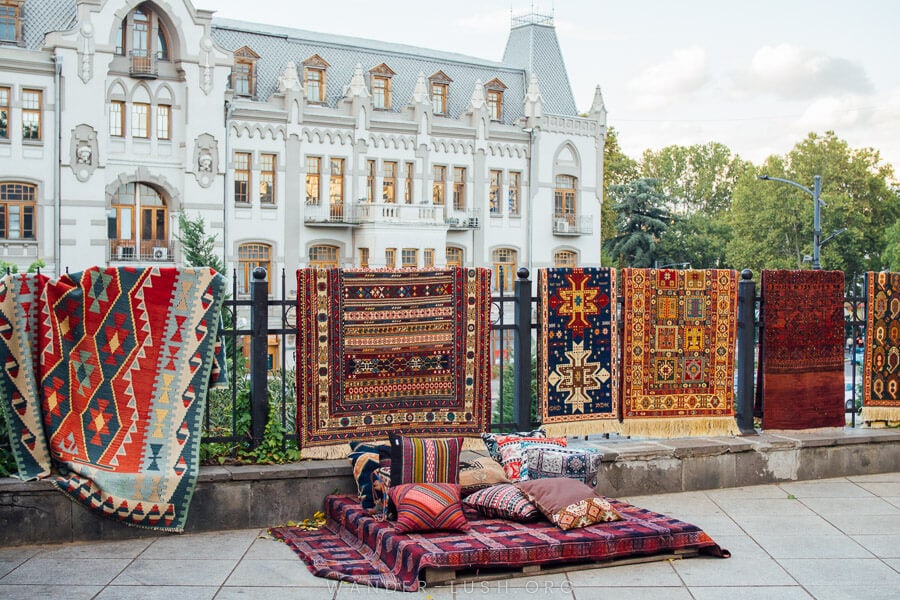
Tbilisi has a well established tourist trail. But you won’t find many of the typical big ticket attractions on this list.
Instead, I want to show you some of my favourite cool, weird, alternative and off-beat things to see, do and experience in Tbilisi – the kind of things that will make your trip unforgettable.
For even more ideas, see my seasonal guides:
Please note: This post contains affiliate links, meaning I may earn a commission if you make a purchase by clicking a link (at no extra cost to you). Learn more.
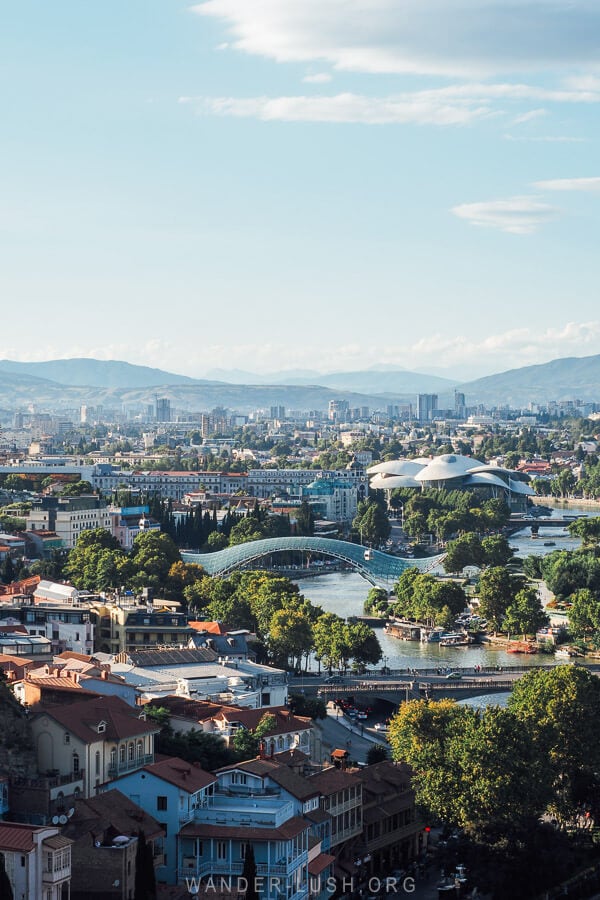
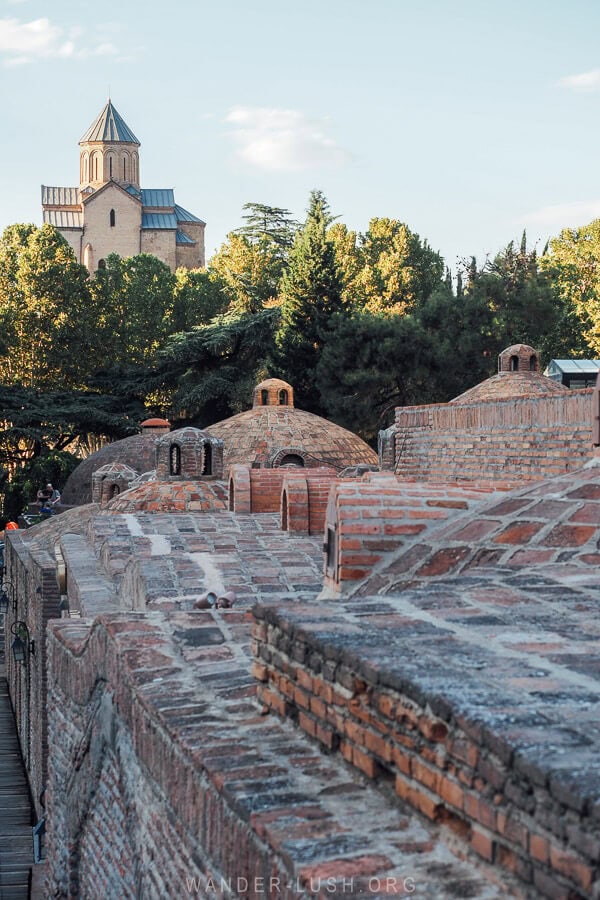
8 quick Tbilisi tips for your trip
Before we discover the best of Tbilisi, here are a couple of quick tips based on the questions I get asked most frequently.
- Avoid summer. Mid-June through to the end of August is peak tourist season and it’s far too hot and cloying to be enjoyable. September/October and May/early June are the nicest times to visit Tbilisi. → See my detailed guide on when to visit Georgia and my Georgia Events Calendar.
- Never take a taxi from Tbilisi Airport. It’s a surefire way to start your trip on the wrong foot. Instead, pre-book a private transfer with GoTrip, use the city bus, or download the Grab app before you leave home. → See my Tbilisi Airport Arrivals Guide for more details.
- Buy a local SIM card when you arrive. It’s essential for booking taxis, general navigation and translation. → See my guide to buying a Georgian SIM card for the best providers and step-by-step instructions for getting set up.
- Stay in Sololaki, Lower Vera, Avlabari or Chugureti. These inner-city suburbs are the most suitable for visitors. You’ll find my accommodation recommendations in the next section.
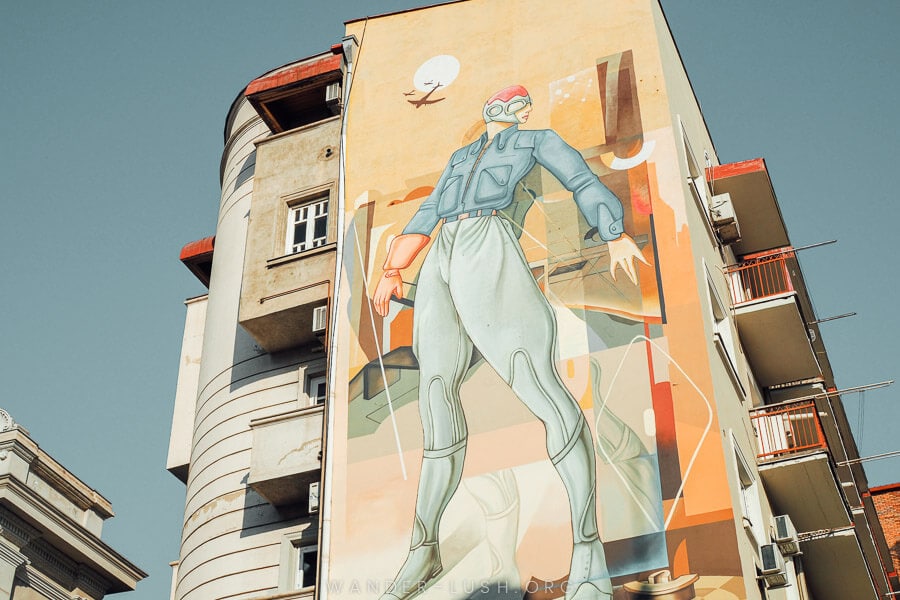
- Adjust to ‘Tbilisi Time’. Tbilisi is a late riser and most restaurants, museums etc. don’t open until 10 or 11am. → If your accommodation doesn’t provide breakfast, here is a list of cafes that open early.
- Remember that Tbilisi is a very safe city. But you still need to exercise common sense. There are a couple of tourist scams to be wary of, and petty theft does occur from time to time. → See my tips for staying safe in Tbilisi.
- Don’t under-budget. Georgia is great value for money, but not everything in Tbilisi is ‘cheap’. → See my detailed Tbilisi travel budget.
- Bring good walking shoes and a scarf. Tbilisi is hilly with cobblestone streets, so your feet will thank you for packing good shoes. Ladies, always carry a lightweight scarf that you can throw over your hair when visiting churches. → Take a peek at my Georgia Packing List.
→ For more helpful tips, here are 23 things to know before you visit Georgia.
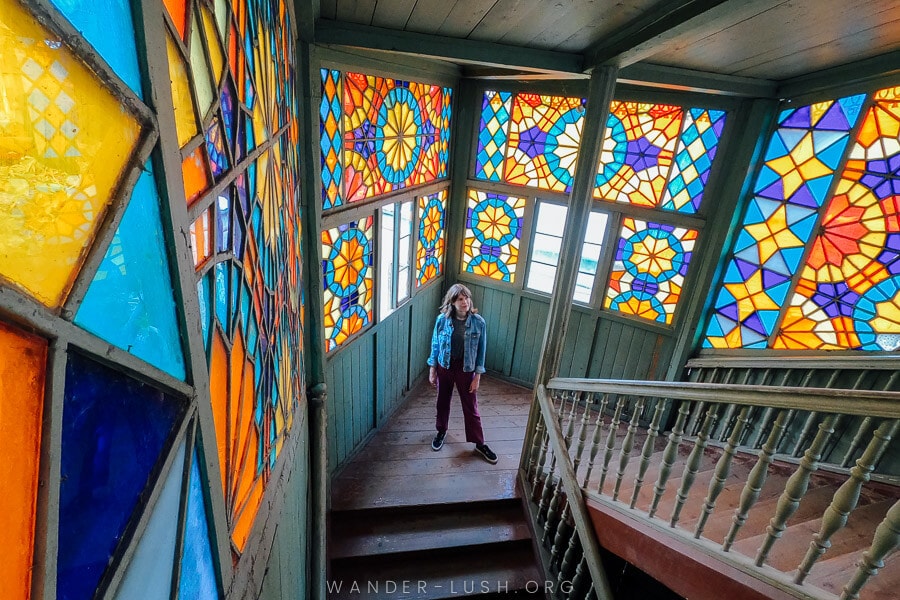
Where to stay in Tbilisi
If it’s your first time visiting Tbilisi, I recommend staying somewhere in the city centre. My favourite neighbourhoods are Sololaki (south-east of Liberty Square), Lower Vera (around Stamba Hotel), Avlabari (across the river from the sulfur baths), and Chugureti AKA Marjanishvili or Plekhanovi (around Fabrika).
All these neighbourhoods are safe with a great local vibe, beautiful architecture, and plenty of restaurants, cafes and bars nearby.
→ I have separate guides for Tbilisi’s best Airbnbs, family-run guesthouses and hostels.
Here are my top overall picks for every budget:
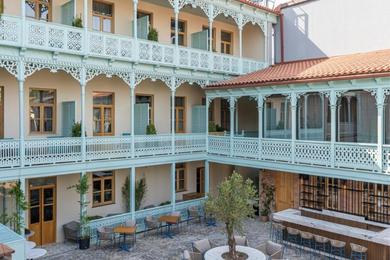
TOP CHOICE: The Blue Fox Hotel (⭐ 9.7). Located in the heart of the old town, this beautiful new boutique hotel has luxe rooms arranged around a typical Tbilisi yard. Enjoy your morning coffee on the pretty blue balcony, then dive into an incredible complimentary breakfast served in the courtyard at The Blue Fox Restaurant.
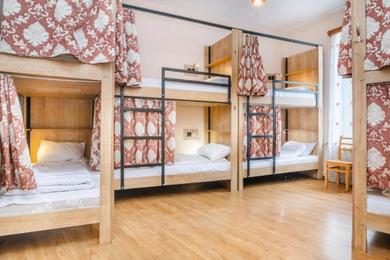
BUDGET: Pushkin 10 (⭐ 9.4). Located 400m from Freedom Square and footsteps from the popular Orbeliani Market and Atoneli Street precinct, this central hostel offers tidy 4 or 8-bed dorms plus private doubles overlooking a shared Tbilisi courtyard. The sunny kitchen and breakfast room with city views is a highlight.

MID-RANGE: Vagabond B&B (⭐ 9.3). Located in hip Chugureti, 600m from Marjanishvili Metro Station, this house has a relaxed, home-away-from-home atmosphere. Singles and doubles have private bathrooms, and shared dining and outdoor spaces are made for coming together over a meal or a glass of wine.

BOUTIQUE: Communal Hotel Plekhanovi (⭐ 9.4). With 14 immaculate rooms, an onsite Levantine restaurant and their own wine bar and gift shop, Communal is one of the best hotels in Georgia. The location in an up-and-coming part of Chugureti is ideal for dining and nightlife. Also see their sister property, Communal Sololaki.

HIGH-END: Stamba Hotel (⭐ 9.2). Located at the top of Rustaveli Avenue, walking distance from both the old town and Vera district, this hotel is nestled inside a former Soviet-era printing house and epitomises ‘industrial chic’. Rooms are stunning, the buffet breakfast is one of the best in the city, and there are several onsite bars.
Tbilisi is just the beginning…
Discover all the best things to do in Georgia! Join my email list and I’ll send you a copy of my PDF guide ‘365 Things to Do in Georgia’.
52 awesome things to do in Tbilisi: The ultimate list
Everything listed here is located within Tbilisi’s city centre and is easy to reach by foot, metro or taxi.
→ For things to do outside the city, see my guide to the 15 best Tbilisi day trips.
Overall best things to do in Tbilisi
Let’s start with the classics. Here are the things I enjoyed most the first time I travelled to Tbilisi and always recommend to friends and family when they visit.
1. Sip coffee inside a former Soviet sewing factory
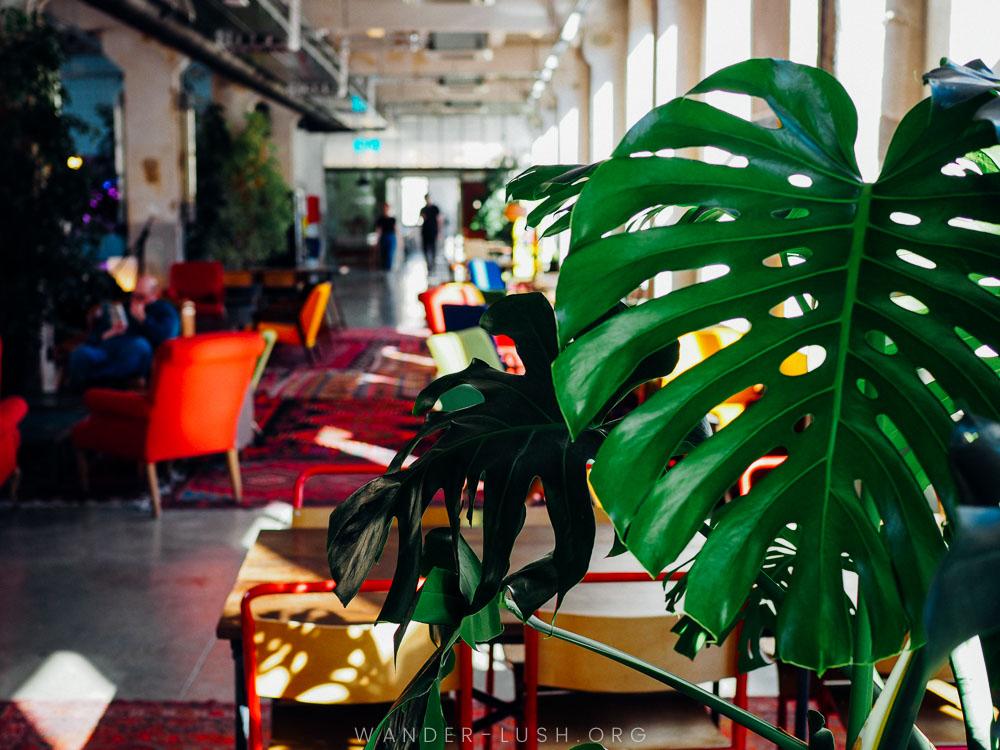
Tbilisi has a knack for taking abandoned, ramshackle buildings – be they old printing presses, power stations or palaces – and relaunching them as vibrant businesses and creative spaces. It wasn’t the first, but Fabrika is the one that really got the trend rolling. The Soviet-era sewing factory reborn as a hostel and multipurpose creative hub is a true icon of Tbilisi.
Some people think Fabrika embodies ‘Tbilisi Cool’. Others see it as a commercialisation of the subculture. Personally, I will always have a soft spot for this venue – it’s simply one of the best places in Tbilisi to drink, eat, shop, work and socialise under one roof.
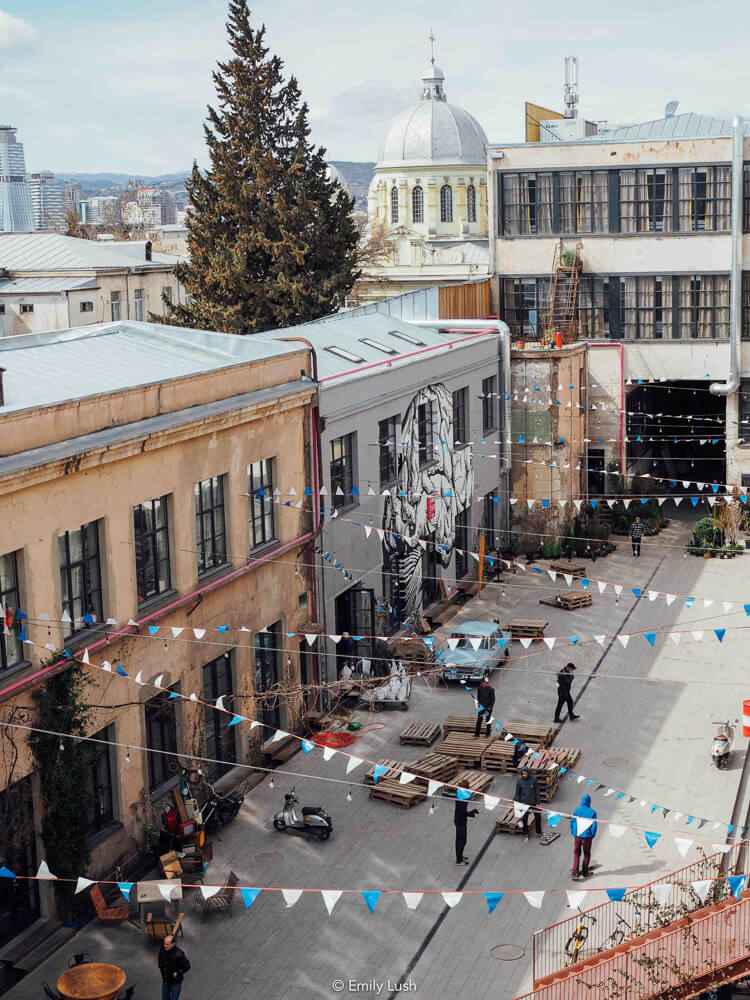
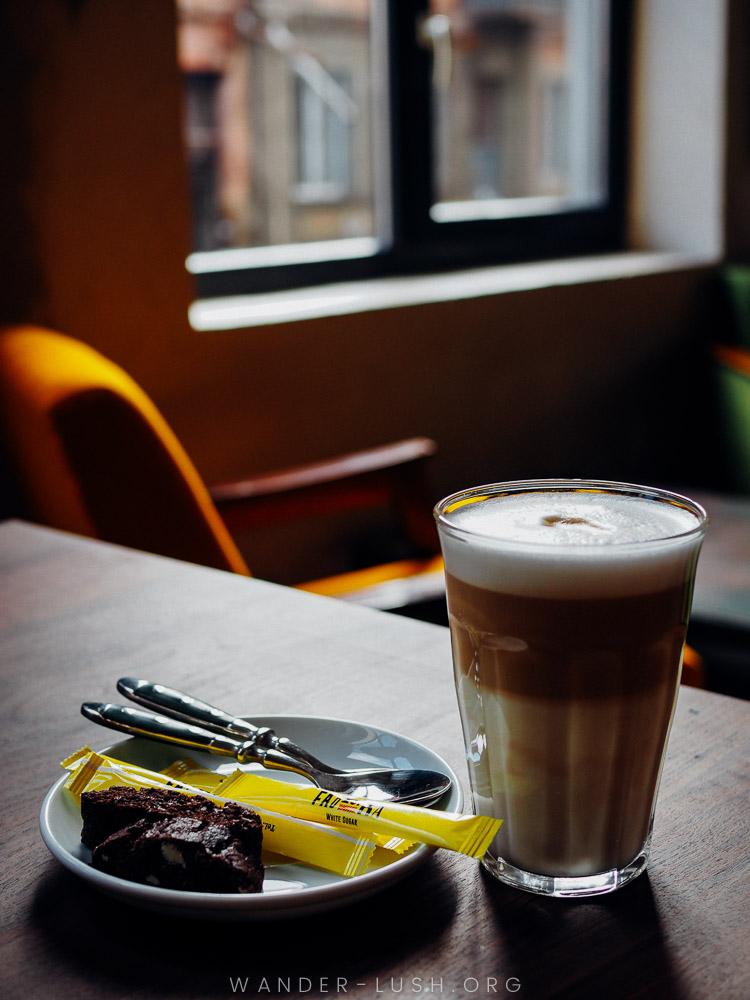
The Fabrika building is a canvas for street art murals. Inside, the ground floor resembles an oversized, light-filled lounge room, complete with a cafe/restaurant, mismatched sofas, and dozens of brightly coloured Caucasian rugs.
The Fabrika Courtyard houses half a dozen cafes, restaurants, bars, and boutiques. In the evenings, the space becomes a communal seating area for all the businesses, and is a great place to sit and soak up the atmosphere. There are regular events here, ranging from film screenings and live music (my husband’s band plays here on occasion!), to book fairs and Christmas markets.
2. Go for a scrub at the Abanotubani Sulfur Baths
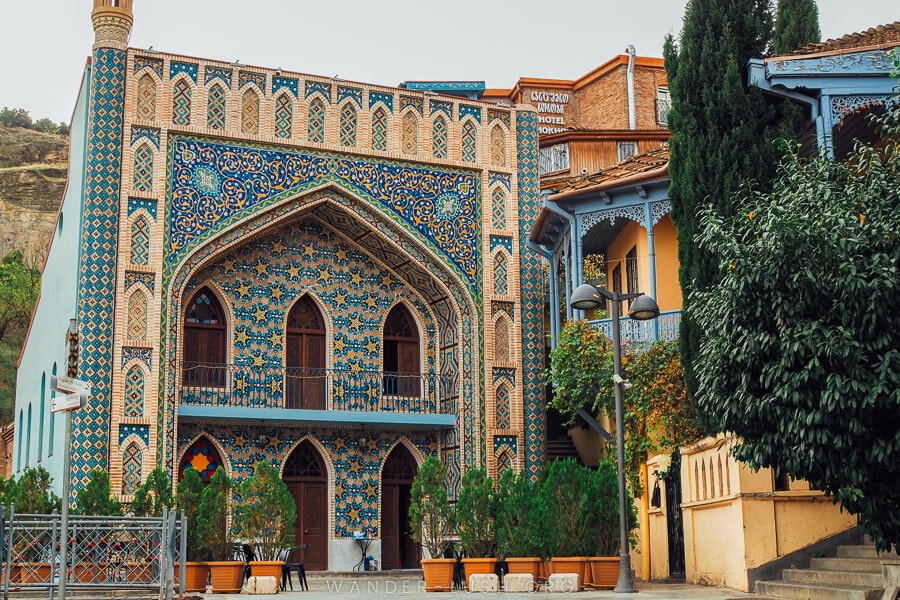
When Tbilisi superseded Mtskheta to become Georgia’s capital in the 5th century, the location for the city was chosen partly because of the natural hot springs that course underground (Tbilisi means ‘warm place’). Persian-Ottoman style bath houses were erected atop this geothermal playground, most of them in Abanotubani, the Old Town’s iconic sulfur bath district.
Each one of Tbilisi’s famous domed bathhouses (there are about a dozen working spas today) taps into the precious warm waters to offer a range of health and beauty treatments. During the 1990s when running water was scarce, many families relied on the baths for daily use. The experience today is far more touristy, but there are some bathhouses that are more authentic than others.

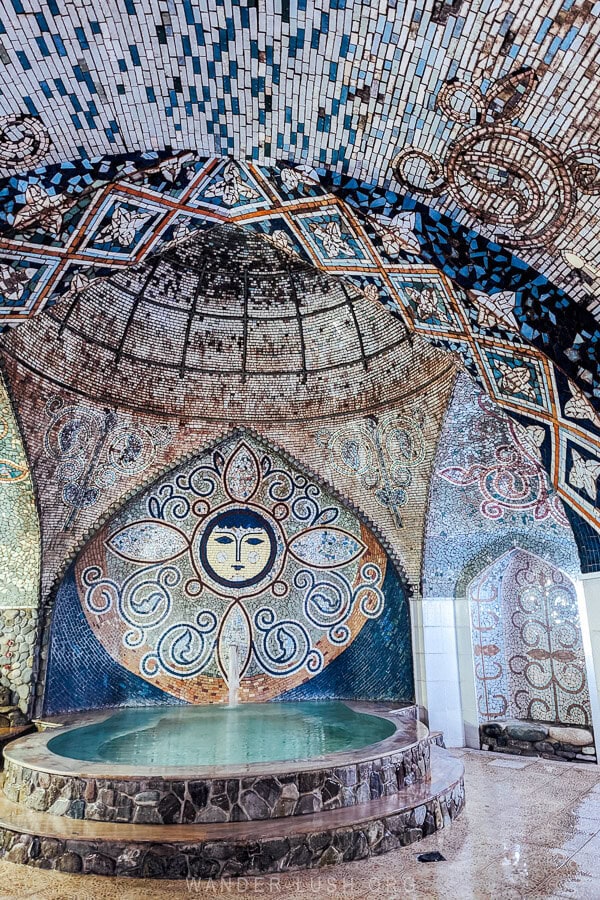
For a local experience, go nude at the sex-segregated public baths. Alternatively, most bathhouses have private rooms where you can bathe and steam solo (or with up to 10 of your closest friends!). Don’t forget to order an exfoliating scrub-down. Called a kisa or kisi, it is similar but oh-so different to a Turkish hammam treatment.
3. Explore the storied Kala & enchanting Sololaki neighbourhoods by foot
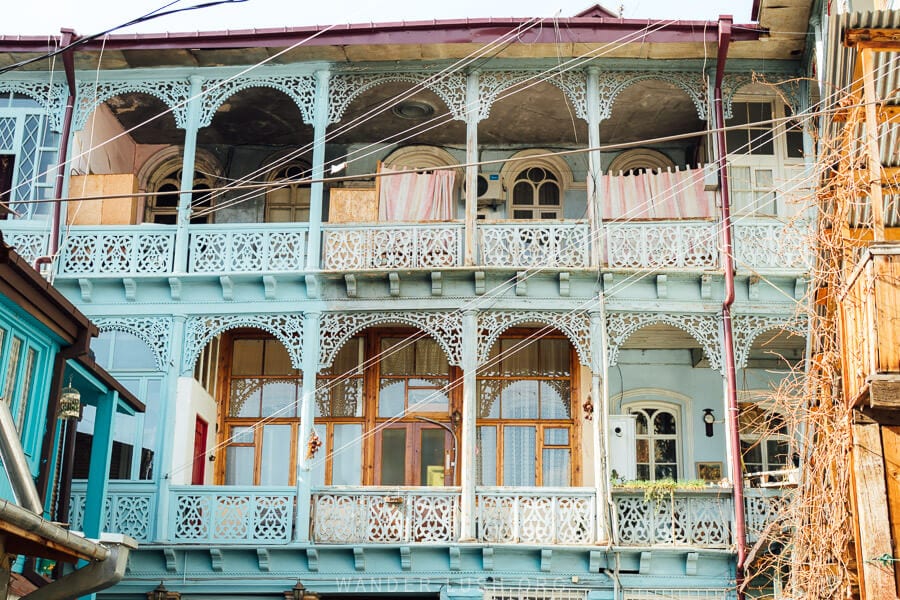
Tbilisi has long been a meeting place for different cultures and creeds – ever since the days of the Old Silk Road. You can smell, taste and hear the legacy of its diversity – but most obviously, you can plainly see it in the city’s eclectic architecture.
To experience the Real Tbilisi, you simply must get out and explore on foot, taking as many deliberate-yet-aimless walks as your feet can handle.
Tbilisi doesn’t have a well-defined ‘old town’ in the same way some other European capitals do. The historic part of the city is a pretty huge area that extends across both sides of the Mtkvari River, taking in the Abanotubani bath district, the old Jewish area, plus Avlabari (the historic Armenian Quarter), and Chugureti (first established as a set of German colonies). Each one is like a city within a city, with its own character and unique style.
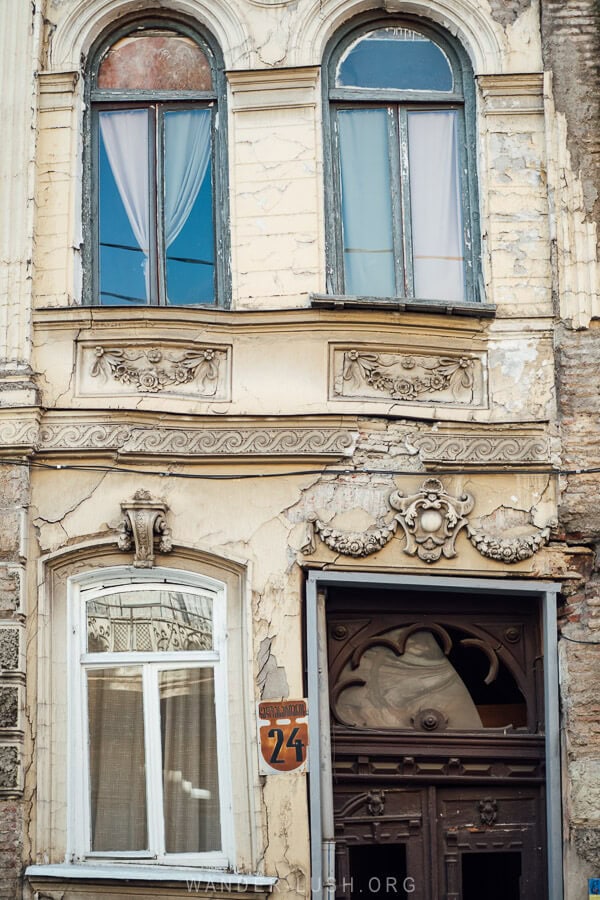
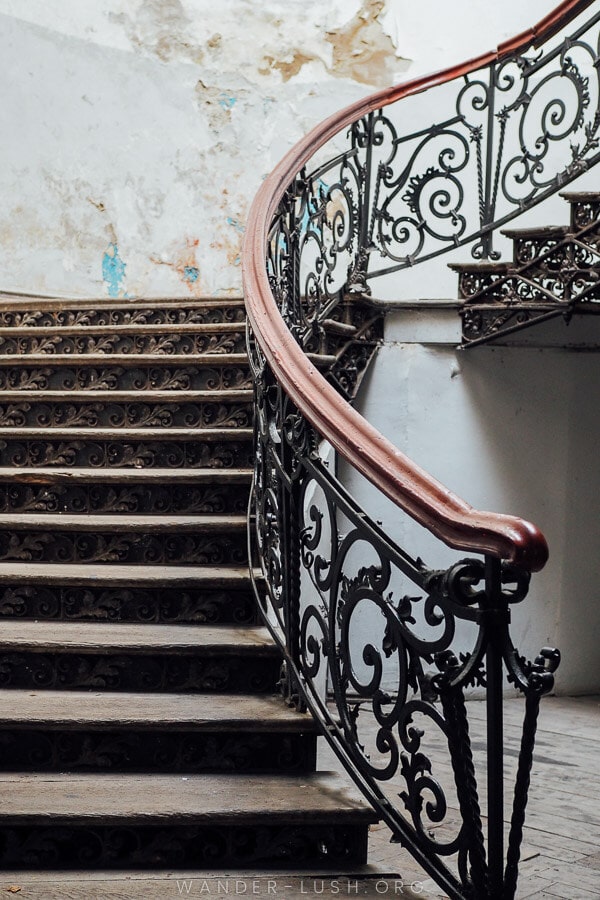
The area most people associate with Old Tbilisi is the Kala or ‘Castle’ district, which sits at the foot of Narikala Castle and was once encircled by defensive walls. The pocket of streets east of Freedom Square, leading down to the river, are particularly atmospheric: All winding alleys, tumbledown houses, courtyards, and grand balconies.
South-west of Freedom Square, Sololaki neighbourhood is a paradise for architecture lovers and street photographers. You can immediately feel the difference as you enter this area: It is more organised, with a gridded street layout and grand facades. There are crumbling beauties around every corner.
My favourite streets in Kala and Sololaki include:
- L. Asatiani Street
- A. Tbileli Street
- G. Kikodze Street
- Vertskhli Street (Silver Street)
- D. Chonkadze Street
- I. Machabeli Street
Some buildings have decorated interiors – see #4 on this list below to learn particular buildings and entryways to look out for.
4. Say Salve to Tbilisi’s painted entryways
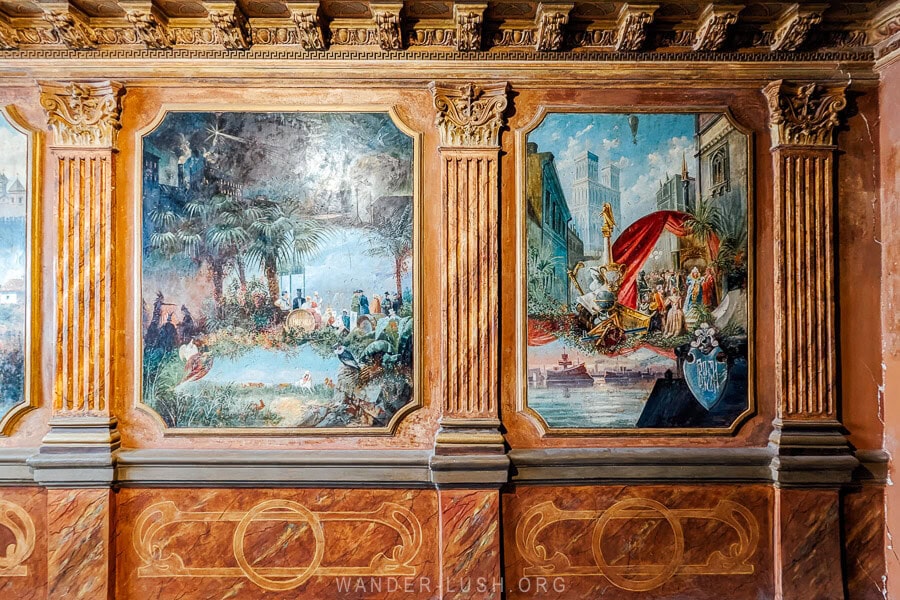
Magical interiors extend all across Old Tbilisi’s different districts, with some of my favourites lying on the opposite side of the river in the Chugureti neighbourhood. Sololaki is particularly famous for its painted entryways, so it pays to have a peek through any and every cracked door you come across whilst walking these streets.
Commissioned by wealthy merchants, manufacturers and traders, some of Sololaki’s oldest houses date back to the 1850s. The majority were built between 1890-1910 on the eve of Georgia’s independence from the Russian Empire, a time when the European style – elaborate stucco and plasterwork, expressive mascarons, shapely portals, bespoke ironwork – were very much in-vogue.
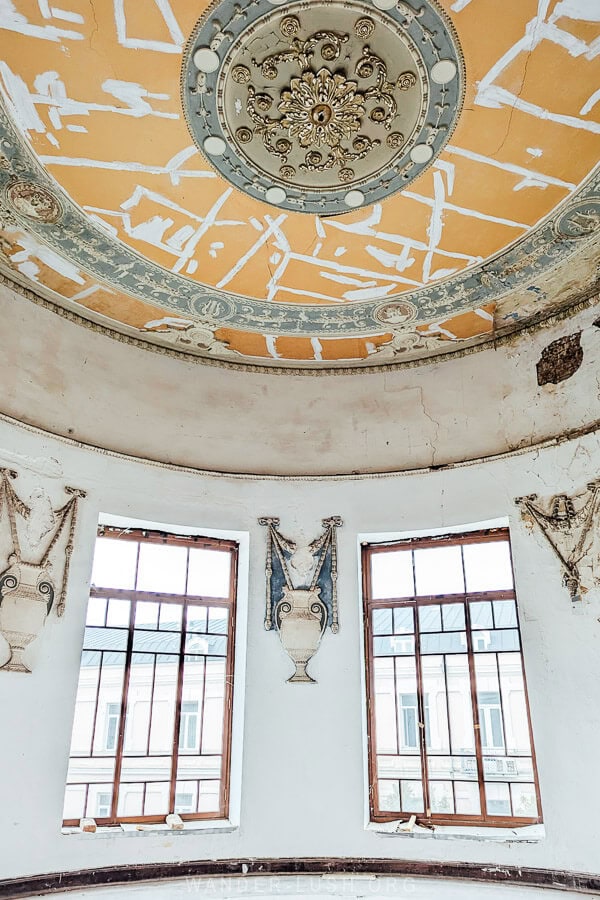
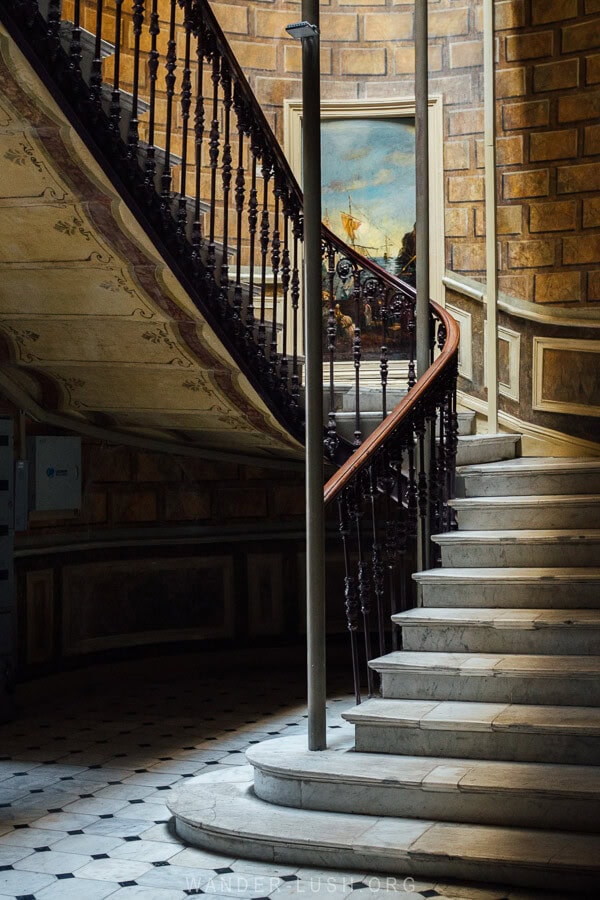
In a fabulous show of one-upmanship, each first-floor apartment entryway was designed to be more elaborate than the neighbour’s. Rich mosaic floors made to resemble expensive Oriental carpets, glazed tiles imported from France, Florentine-style tempera paintings and Venetian coloured glass: No expense was spared in ensuring that guests were wowed from the first moment they stepped through the door.
At the threshold of many of these buildings, the Latin word ‘Salve’ (a greeting and wish of good health) is emblazoned in the terrazzo. This sweet sentiment captures the spirit of Tbilisi so well.
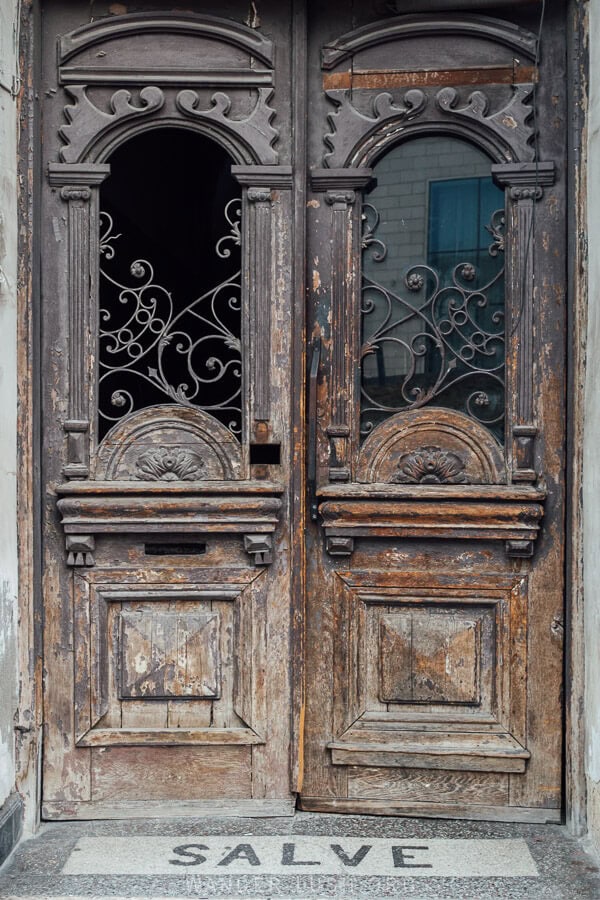
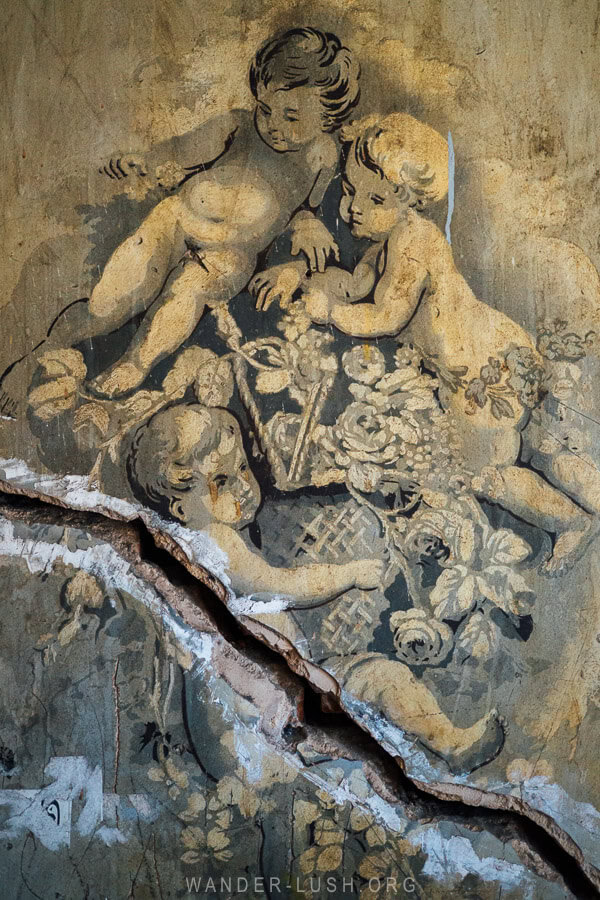
When these private apartments were later Sovietised and carved up, the ground-floor vestibule became a common thoroughfare for the families living there. Some were maintained or have since been restored, while others have not fared so well.
These entryways are considered part of the city’s shared cultural heritage, and visitors are usually welcome to venture into the foyer or the stairwell for a peek – unless otherwise indicated. Oftentimes, the front door will be left ajar. On more than one occasion, I have been moseying around outside a house only to have a passerby give me the punch code to open the door! Just remember that people live in these buildings, and you should be as discrete as you possibly can.

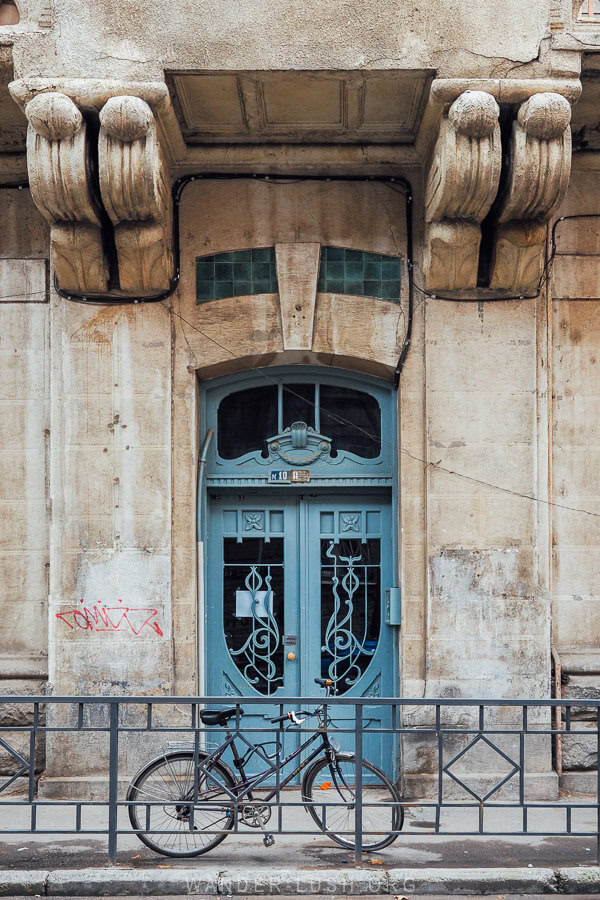
Some of my favourite entryways include:
- 17 Ivane Machabeli Street
- 18 Tabidze Street (Brothers Seilanov House, pictured above)
- 9 Geronti Kikodze Street
5. Embrace Italian courtyard culture

One quirk of the city’s anatomy that you’ll see all over Tbilisi (especially in Sololaki and Chugureti) are the so-called ‘Italian courtyards’. Behind seemingly uniform and tidy stone facades lies a tangle of gardens, water wells, balconies, covered walkways, galleries, and spiral staircases.
The development of this style of communal living was influenced by old Silk Road caravanserais, where there was always a central area for socialising and negotiating deals. Later on, during Georgia’s time as a Soviet Republic, many private homes were divided up to make room for the many thousands of families ushered into the city. Extensions were hastily made and external staircases tacked on to create new entrances. This explains the hodgepodge appearance of some buildings.
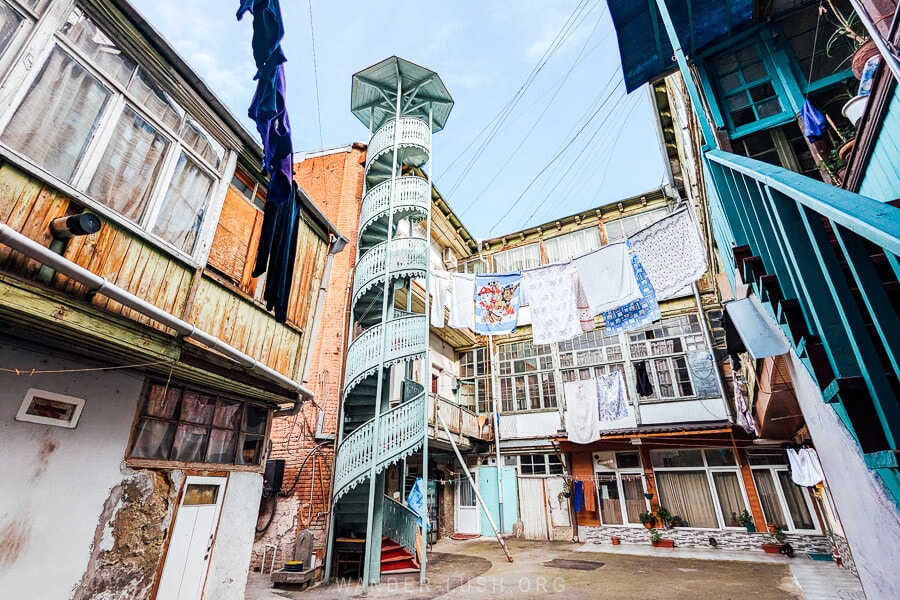
Tbilisians started referring to their outdoor spaces as ‘Italian courtyards’, apparently as a nod to the Mediterranean-inspired lifestyle they evoke (or the popularity of Italian cinema at the time!). In truth, there is nothing Italian about these shared in-between spaces – courtyard culture is something utterly Tbilisi. Each yard is brimming with life, almost like a mini ecosystem with its own rules and daily rhythms.
One of my most enduring images of Tbilisi involves a line of underwear strung over a courtyard between two balconies, flapping lazily in the breeze. You’ll learn to recognise and love laundry days, when the whole city hangs its clothes out to dry in a photogenic display.
Another great way to experience the Tbilisi courtyard is by dining at a courtyard cafe. Mova Maisi, Sofia Melnikova’s and Restaurant Littera are just a few of my favourites.
6. Comb through kitsch at the Dry Bridge Flea Market
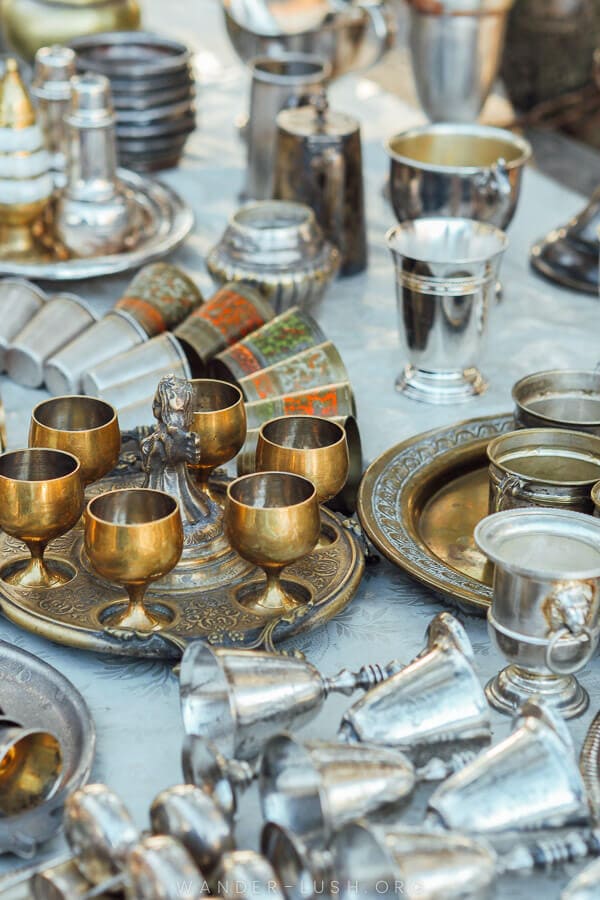
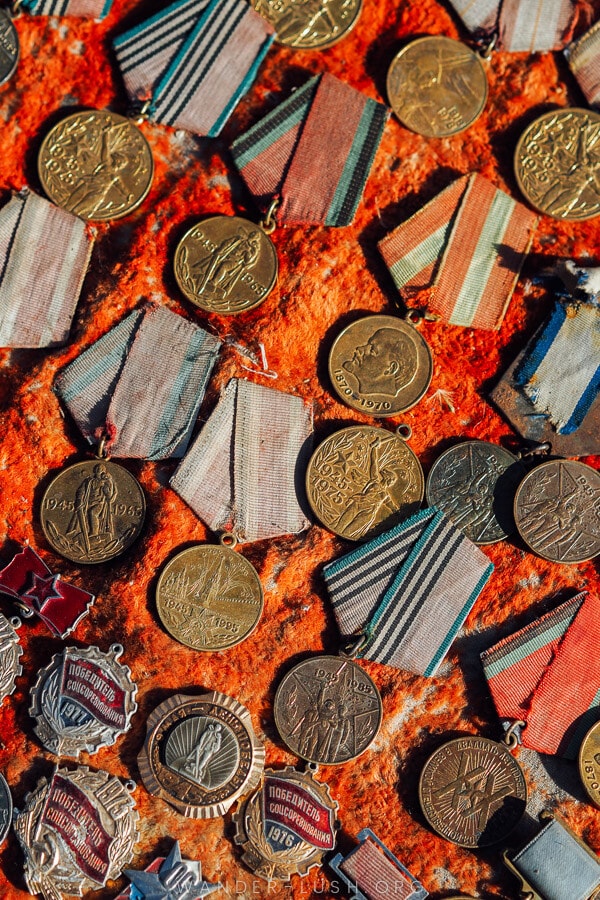
The Dry Bridge Market (so-called because the bridge it is staged on once spanned the Mtkvari River, but is no longer ‘wet’ because the river was filled in) is a huge open-air flea market that takes place 7 days a week, 365 days of the year (weather permitting, of course). Whether you’re hunting for a particular treasure or just interested in browsing, a visit to the Dry Bridge is a must-do in Tbilisi.
Hundreds of vendors convene to pedal boundless quantities of antiques, vintage paraphernalia, and Soviet kitsch, including war medals, vinyl, KGB ID books, gas masks, chandeliers, maps of the former USSR, Soviet-issue film cameras, retro Christmas decorations – and anything and everything else you can imagine. Be warned: Some vendors drive a hard bargain!
Underneath the bridge and in the adjoining Dedaena Park, painters set up their easels and makers sell handmade souvenirs.
7. Discover Georgian food beyond Khinkali and Khachapuri

On my first visit to Tbilisi, I met more than a few travellers who had come to Georgia just for the food. I can totally sympathise: Georgian cuisine is definitely one of the most underrated on Earth. Yes, some dishes are decadent – heavy on carbs and dairy – but at the same time, the Georgian table is surprisingly fresh, fragrant and flavoursome.
Khinkali – doughy dumplings filled with meat, mashed potato, cheese, or any number of savoury ingredients – and khachapuri – Georgia’s famous ‘cheese bread’ – dominate social media. But these two staples are just the tip of a very large iceberg.
So once you’ve ticked off the top two delicacies, the quest to taste delicate soups, hearty stews and vegan-friendly appetisers begins. You will soon discover that there are a dozen different cuisines within Georgia’s regions – my Tbilisi Restaurant Guide features a dedicated section on regional kitchens to help you find the best Megrelian kharcho, Kakhetian mtsvadi, and more.
After years of eating Georgian food almost every single day, I have yet to tire of it – there’s just that much variety baked-in.
8. Do a Georgian wine tasting

In Georgia, wine is both sacred stuff and serious business. The 8,000-year-old method of making qvevri wine in clay amphora is a UNESCO-recognised tradition, and an integral part of culture and identity. Even if you’re not into vino – and even if you don’t drink! – I still recommend at least one wine-related activity as a window into this world.
There are hundreds of endemic grapes in Georgia, and literally thousands of varieties of wine. Be sure to try at least a couple of ambers and of course the legendary Saperavi.
If you want to sample bottles from small family vineyards and alternative appellations in areas such as Kartli and Upper Adjara, a sit-down wine degustation is one of the best things to do in Tbilisi. 8000 Vintages hosts budget-friendly tastings led by a professional sommelier, and is my top choice.
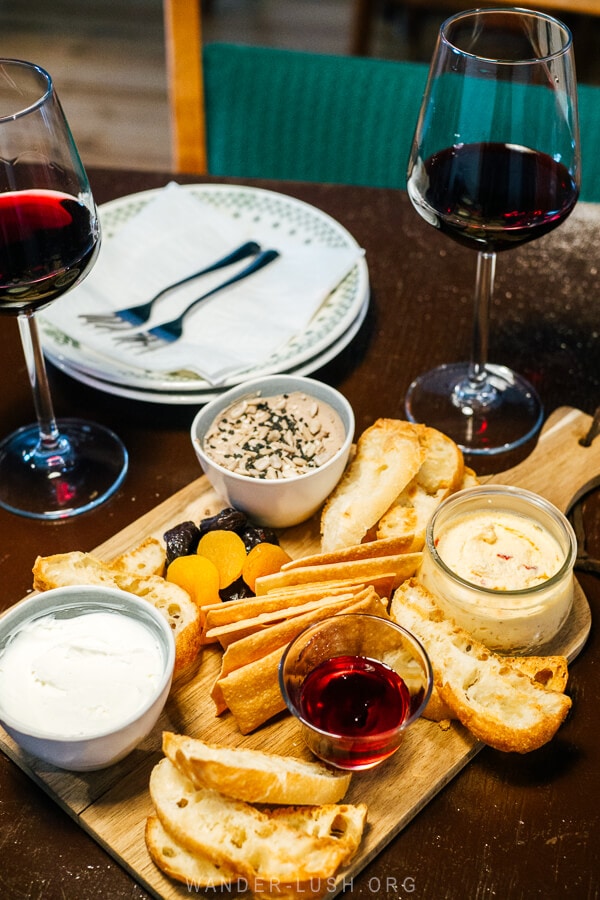
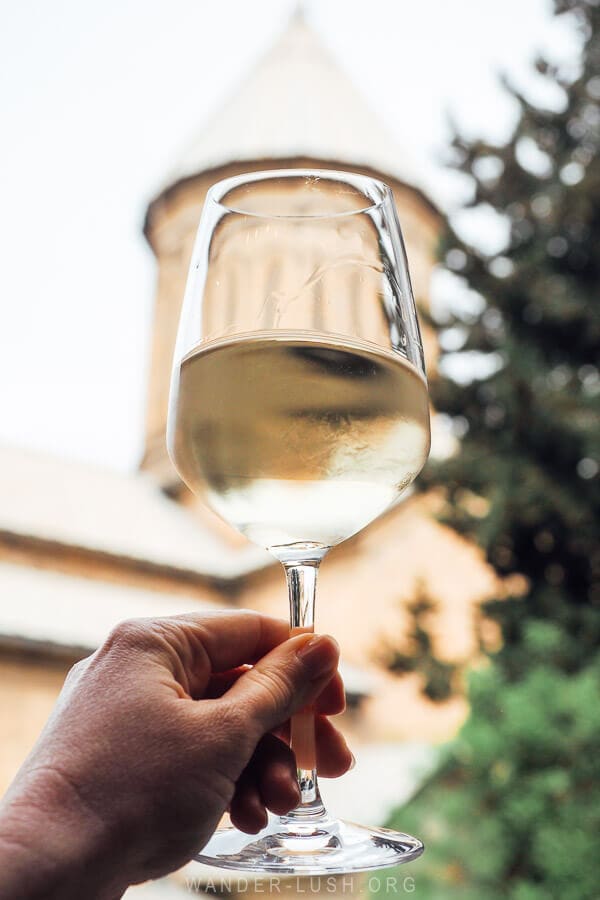
Other venues that offer three or five wine flights include Wine Merchants in Chugureti, and Nino Meris Wine Selection in Kala old town. For rare reserves and top-shelf bottles to take home, I recommend Warehouse inside Stamba Hotel, and Wine Code in Avlabari.
If you’re serious about wine, you will definitely want to head out of Tbilisi to explore Kakheti, Georgia’s biggest and most productive wine region. Check out my transport guide for getting to Kakheti from Tbilisi and my detailed guide to visiting Kakheti, the cradle of viticulture.
9. Listen to polyphonic chanting at Tbilisi’s oldest Orthodox church
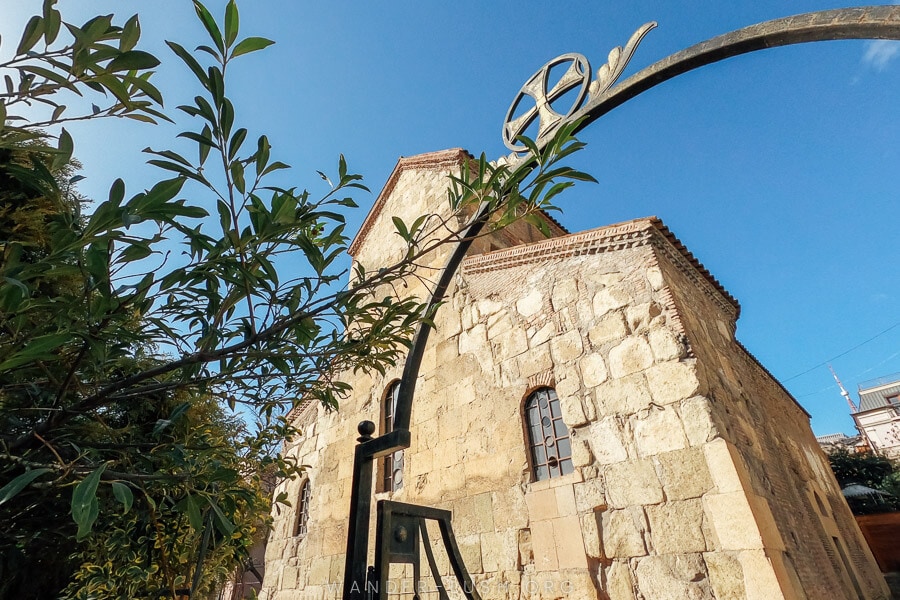
Right beside one of Tbilisi’s most-visited tourist attractions, Rezo Gabriadze Square and its leaning clock tower (also see #51 below), tiny Anchiskhati Basilica is hidden away and quite conspicuous. It’s not one you want to miss, though – especially on a Sunday morning, when the chapel rings out with rousing polyphonic chanting.
If you’re not familiar with Georgian polyphony, this is a unique vocal style that involves singing multiple melody lines in unison. It is a secular tradition that predates Christianity, but a version of it is performed during the Orthodox liturgy. Listening to a well-rehearsed ensemble is almost an otherworldly experience, especially in a church where the acoustics are tailored-made for it.
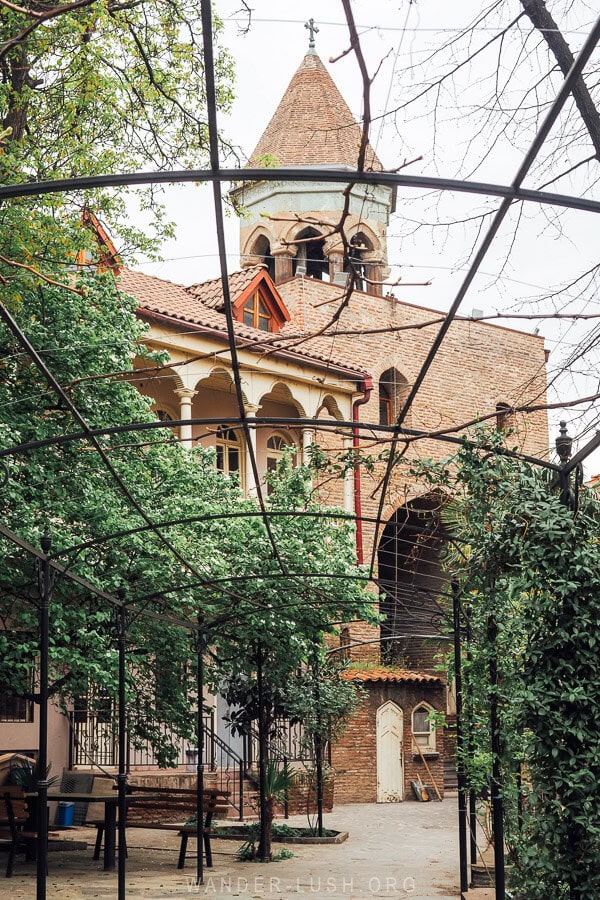
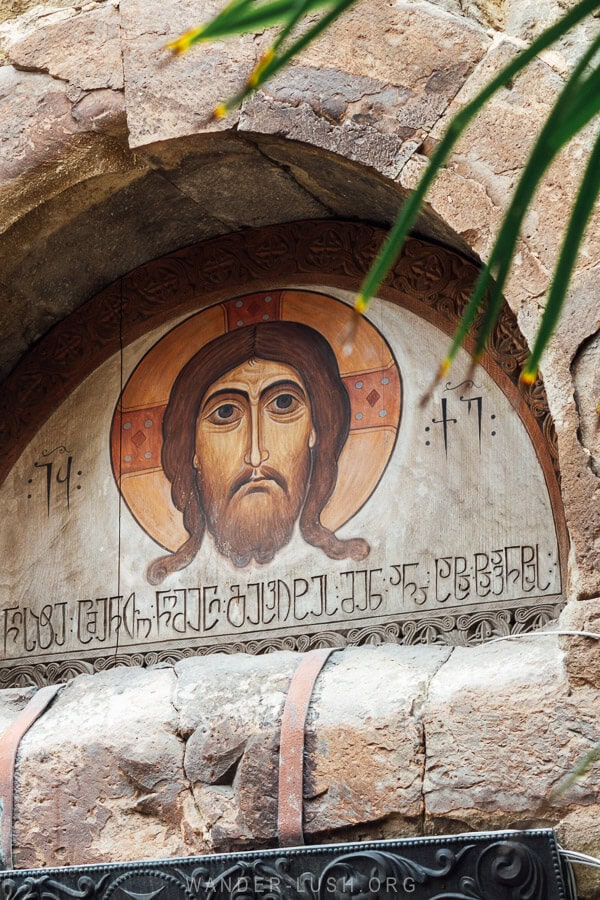
Anchiskhati Basilica, home of the world-renowned Anchiskhati Choir, has daily liturgy and a Sunday morning service, with polyphony that starts from around 10am. Visitors are welcome to join provided you are discreet and follow the dress code (see my tips below). I recommend finding a quiet place to stand at the back. You can slip in and out whenever you want to.
Other churches in Tbilisi with beautiful liturgy services include Sioni Basilica, and the Holy Lord’s Transfiguration Convent on the grounds of Queen Darejan’s Palace (also see #26 below).
10. Feel small at Holy Trinity Cathedral (Sameba)
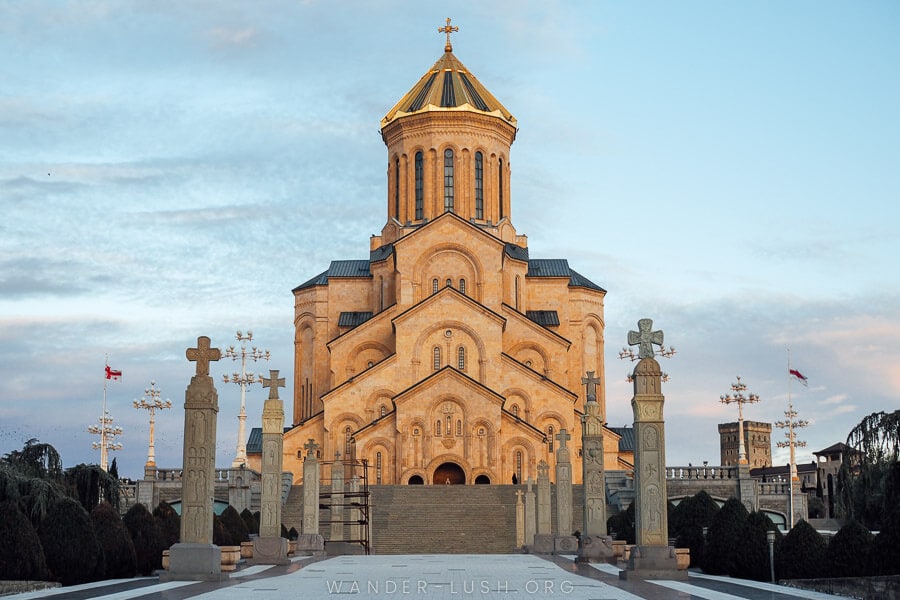
At the opposite end of the spectrum to Anchiskhati, Sameba or Holy Trinity Cathedral is Georgia’s largest church. Its gilded dome is a symbol of the city and can be spotted from just about anywhere in Tbilisi, especially at night when it is illuminated with flood lights.
But it’s only once you’re up close that you feel the true scale of this imposing building – one of the tallest Eastern Orthodox churches in the world. Holy Trinity took almost a decade to build, and was only completed in 2004 with the help of donations from generous Tbilisians.


When you arrive at the top of Elia Hill, a promenade leads to the base of a cascading stone staircase, which you must summit to reach the main doors. The opulent cathedral interior is all marble and gold. The outside is equally spectacular, especially the view of the towering facade on approach.
11. Marvel at the ultra-modern architecture around Rike Park
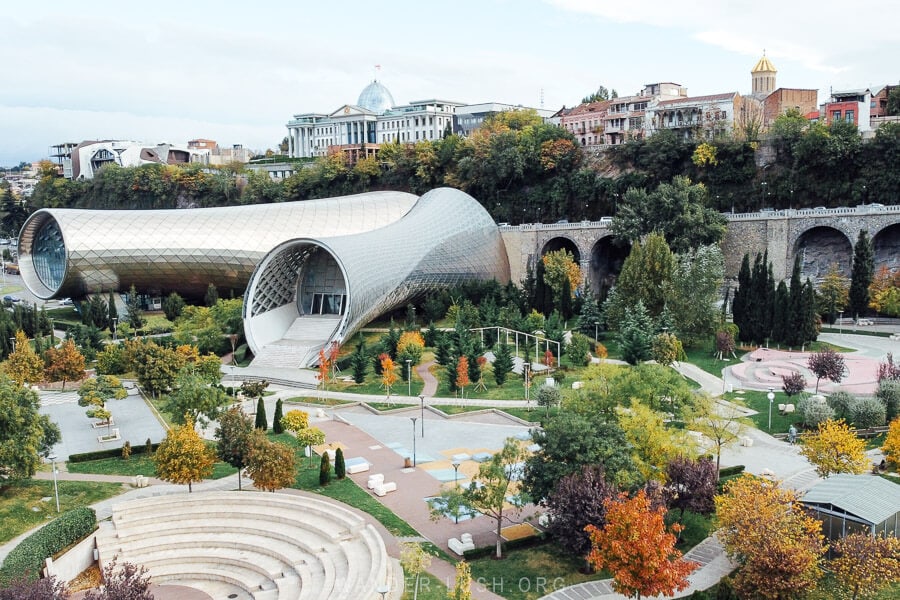
Juxtaposed with its gracefully (and not-so-gracefully) ageing historic homes, Tbilisi’s modern architecture definitely errs on the extravagant side. Several of the most recognisable structures on the skyline can be seen from Rike Park, the riverside parkland that stretches along the Left Embankment, below Avlabari and Sameba Cathedral. For the best view, climb the staircase at the back of the park to reach Baratashvili Rise.
The Bridge of Peace raised some eyebrows when it was completed in 2010. Designed by Italian architect Michele De Lucchi, its curved steel and glass canopy extends over the river, connecting Rike with Kala’s Erekle II Street. Come sunset, more than 1,200 LEDs light up the bridge’s glass railings and pulse with different patterns.

The futuristic Rike Concert Hall (2012) sits at the northern end of the park. Designed by Massimiliano and Doriana Fuksas, twin ‘Rike Jugs’ lie unused and off-limits. In March 2022, the concert hall sold at auction (in early 2025, it changed hands again), and it is slated to become galleries, exhibition and conference spaces.
The State Palace of Ceremonies, formerly the Presidential Palace (2009), rises up behind the Concert Hall, its kitsch arcades and glass dome just visible on the hillside. It no longer serves as the Presidential Administration – the new residence is located on Orbeliani Square.
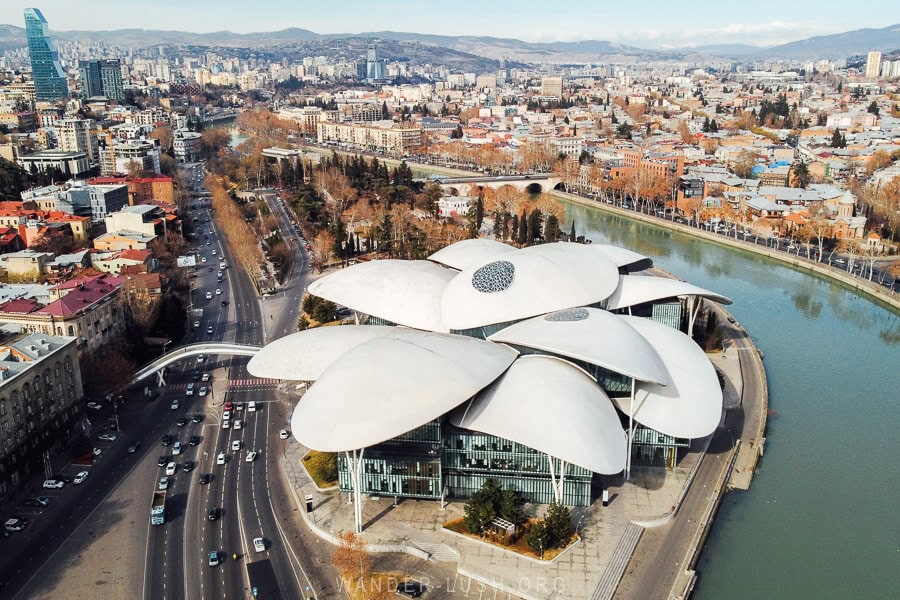
Another striking building, the Public Service Hall or Justice House, has earned the nickname ‘Mushroom Building’ for obvious reasons. It can be seen from the Baratashvili Bridge.
To view Tbilisi’s contemporary architecture is also to get a lesson in modern politics. These ostentatious buildings were dreamed-up by former leaders, and all have a story (perhaps even a scandal) behind them.
12. Shop for Lurji Supra & other traditional Georgian handicrafts

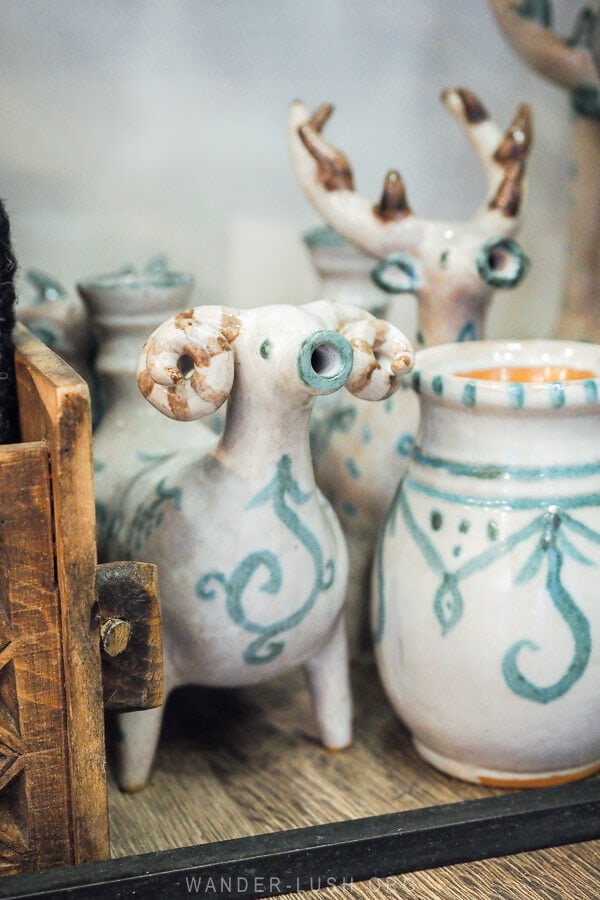
Georgia has a rich array of heritage crafts and a vibrant arts scene, encompassing everything from woodwork and stonemasonry to Cloisonne enamel and felting. If you’re looking for something special to take home, there are some excellent independent shops in Tbilisi that specialise in handmade souvenirs sourced ethically from makers around the country.
My top pick for a Tbilisi souvenir is a Lurji Supra. Georgia’s signature blue-and-white tablecloths feature traditional symbols, and are traditionally printed on cotton. I own half a dozen of them at least!
My favourite Tbilisi souvenir shops include:
13. Climb the Academy of Arts stairs & visit the Qajari Mirror Halls

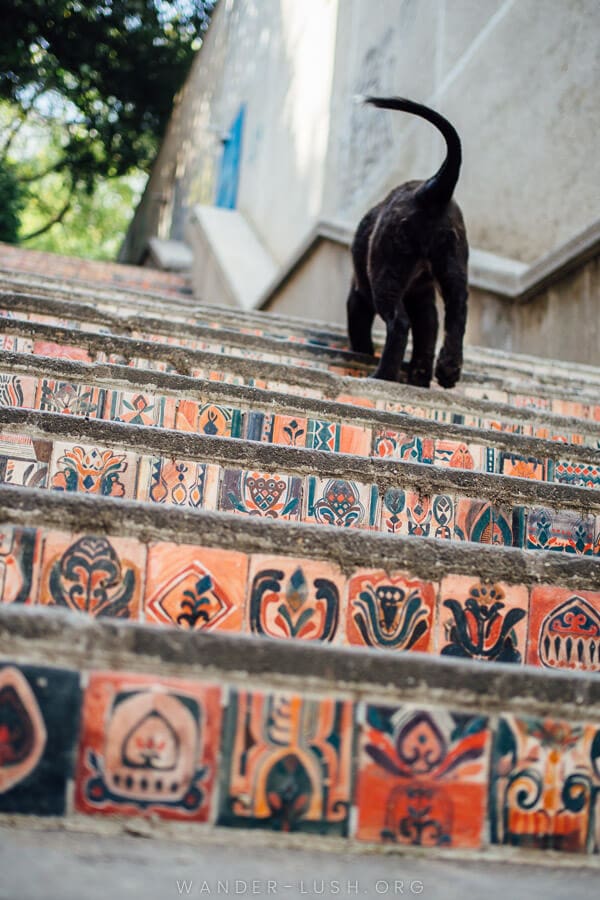
Clay pottery is another long-standing craft tradition in Georgia. As you wander the Old Town, you will see beautiful ceramic signs on some streets. Also look out for the tile plaques on Rustaveli Avenue that bear maxims from the epic Georgian poem, The Knight in the Panther’s Skin.
On the western side of Rustaveli Avenue there is a long flight of stairs that leads up to the Tbilisi State Academy of Arts on Griboedov Street. Each riser has been decorated with gorgeous hand-painted tiles, adorned with patterns and symbols.
We have Ninka Sajaia and Ketevan Chichveishvili to thank for this public work. At their studio-shop, Ceramic Room, the pair sells souvenir-sized tiles and household ceramics.
When you reach the top of the stairs, be sure to pop inside the incredible State Academy of Arts main building. Formerly a private mansion house belonging to the Armenian merchant Vardan Astvatsatryan Arshakuni, it was built at the end of the 19th century then bequeathed to the city.

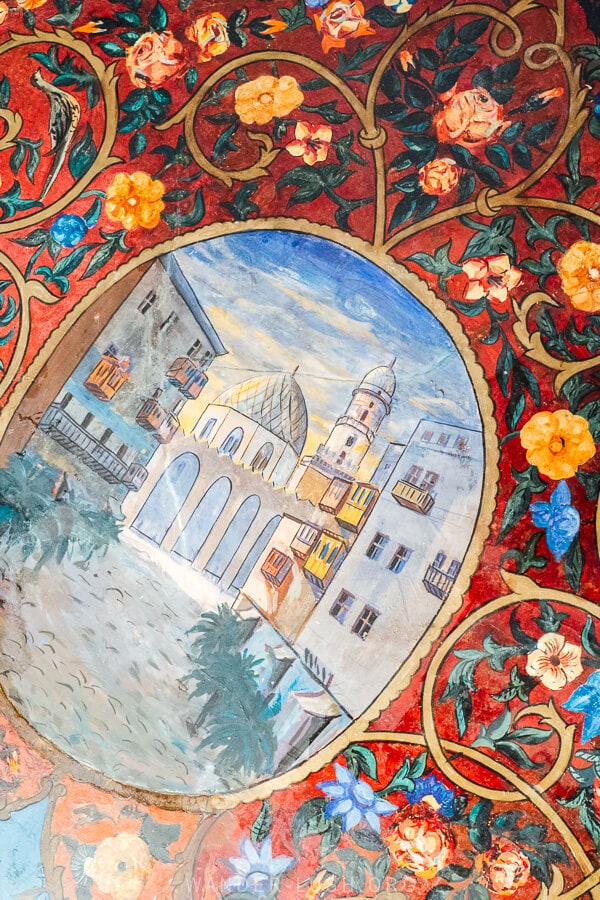
The State Academy of Arts Museum is open on weekdays during the university semester. Buy a ticket to tour several of the most opulent rooms, including the ‘mirror halls’ that are decked out with mosaics and miniature paintings created by Persian master craftsmen.
14. Go inside ‘the Apple of Love’
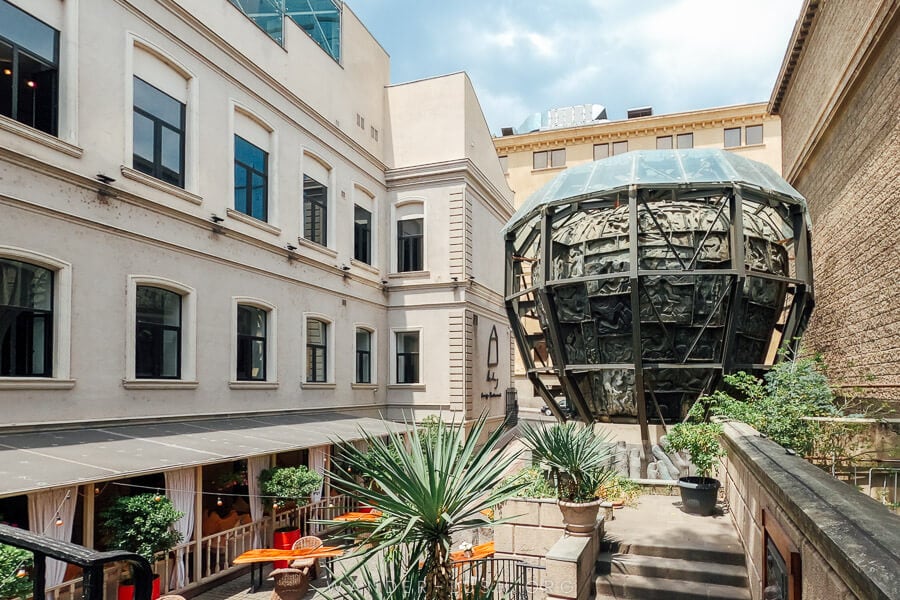
Rustaveli Avenue is known for its museums and galleries (see #41 below for my top pick). While MoMA Tbilisi is far from my favourite art gallery – the Museum of Fine Arts (MFA) and the Art Museum of Georgia (off Freedom Square) offer much more bang for your buck – I do recommend stopping by MoMA to see another intriguing art installation, located almost directly opposite the ceramic stairs.
Created by the late Georgian sculptor Zurab Tsereteli (who also designed the Chronicles of Georgia monument, #46 on this list, and contributed to the interior of Saint Sava Church in Belgrade, Serbia), The Apple of Love is a nine-metre-tall, hollow sculpture. It is the star of MoMA Tbilisi, the museum Tsereteli himself founded in 2012 to exhibit his own works.

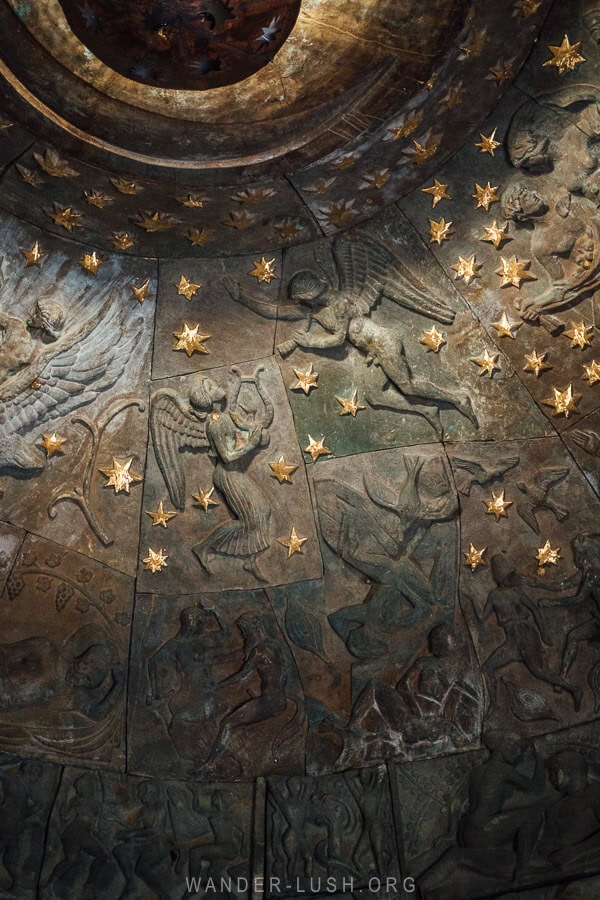
From the outside, the sculpture is more than a bit mysterious. Then you notice the small doorway. On the inverse side, there’s just enough light to decipher 145 bronze relief panels that tell the story of the origin of life.
A warning to parents: Some of the scenes are quite graphic!
15. Search for Georgia’s national painter on the Pirosmani Route, one of the best things to do in Tbilisi for art lovers
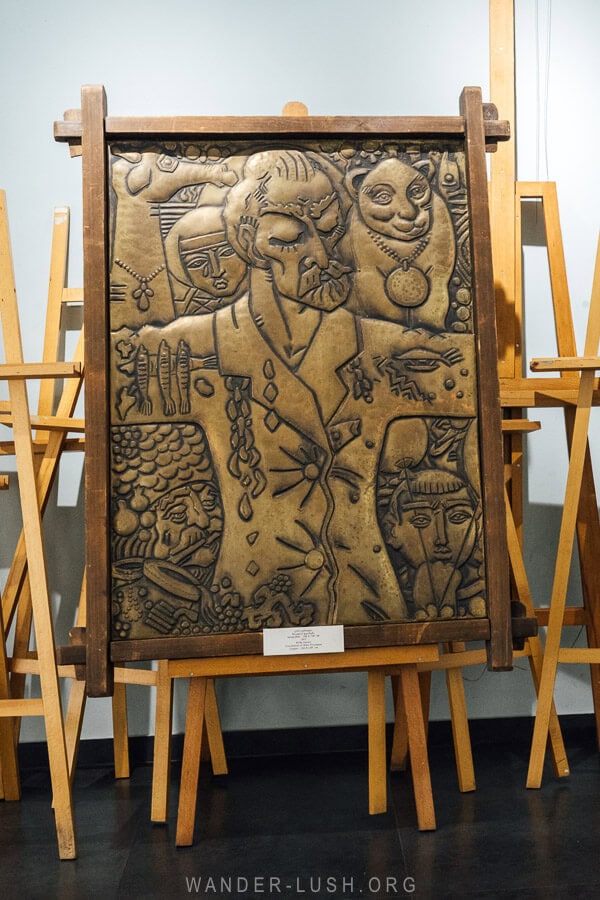
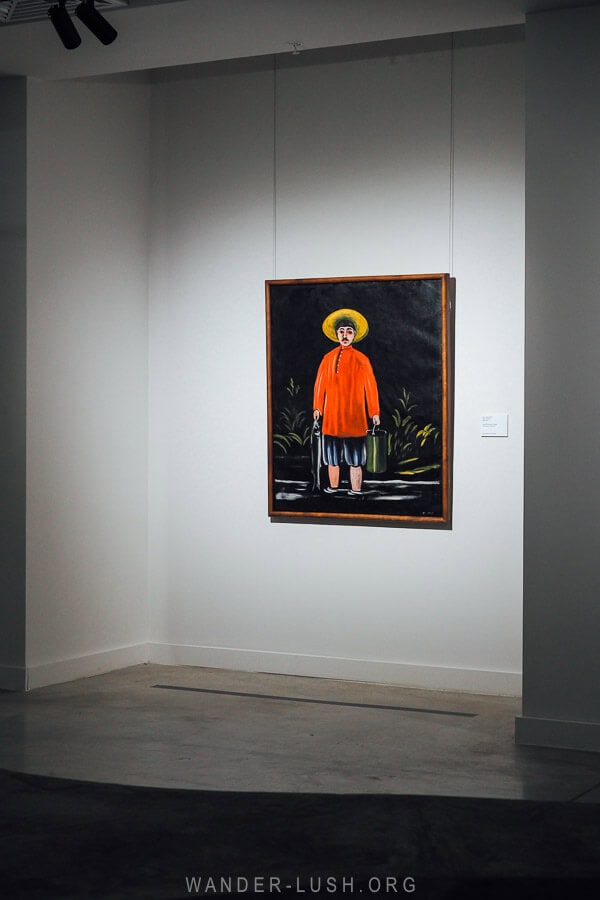
Born in 1862 in Mirzaani village in Kakheti, Niko Pirosmani (Pirosmanashvili) is Georgia’s most beloved painter. Self-taught, he lived in poverty and only rose to prominence after his death in 1918.
Sometimes called the ‘Henri Rousseau of the East’, Pirosmani began his career by hand-lettering shop signs and sketching murals on tavern walls. Nikala’s Primitivist style and deep sincerity was used to depict various Georgian traditions, including the Rtveli grape vintage, and the Easter table. He had a knack for bringing the everyday minutiae of Old Tbilisi to life, and often painted the city’s most colourful characters – merchants, shopkeepers and entertainers.
Some of Pirosmani’s 200 surviving paintings (a mere 10% of his catalogue) – including what is perhaps his most recognisable work, Fisherman in a Red Shirt (1908) – are on display at the Art Museum of Georgia and the National Gallery in Tbilisi. A few of his early creations, including hand-painted signboards, can be seen at the Art Palace in Chugureti (see #16 on this list below).
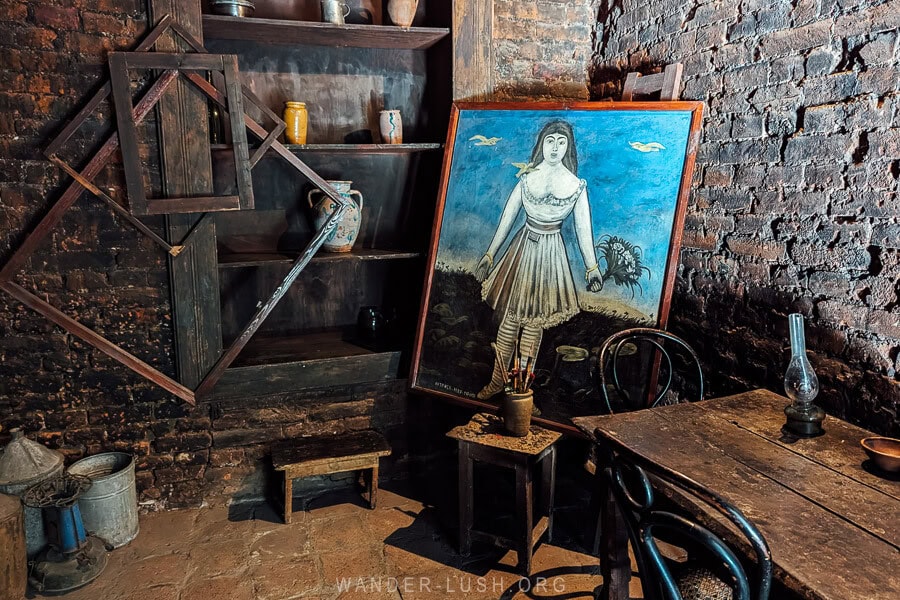
Pirosmani lived and worked in a tiny apartment close to Tbilisi’s Central Railway Station. It 1982, the room under the stairs was turned into an apartment-museum, with a recreation of Niko’s workspace and a homage to the artist in a collection of mixed-media portraits.
16. Tour an offbeat museum


While the big-name institutions on Rustaveli Avenue are one thing, I think that independent and quirky museums are Tbilisi’s real forte. There are excellent small museums and house museums that explore all manner of niche interests, from retro Soviet cars to folk medicine.
One of my personal favourites is the Art Palace. Set inside a magnificent house designed by Paul Stern in 1895, it’s a twofer: Not only are the objects on display inspiring, but the building itself is a work of art. Officially the Georgian State Museum of Theatre, Music, Cinema and Choreography, it houses a private collection of manuscripts, sculptures, sheet music, theatre costumes, paintings and sketches.
Another must-see is the State Silk Museum. Devoted to showcasing Georgia’s incredible legacy of silkworm rearing and silk production, it is one of the oldest museums of its kind in the world. It just recently reopened in October 2024 following a long closure for renovations.


Other museums I recommend visiting in Tbilisi include:
- The Tbilisi Auto Museum
- The Museum for the History of Georgian Medicine
- The Museum of Books
- The Museum of Repressed Writers
- The Bitadze Tea Museum (see #32 below)
17. Search for street art

One of the things you might notice when walking around Tbilisi is the prolific amount of street art and tags. Organised street art is a relatively new phenomenon in Georgia, but it has only taken a couple of short years for artists to make their mark on the city. Works range from large-scale murals plastered on the sides of 17-storey apartment buildings in Saburtalo and Varketeli, to smaller paintings hidden in laneways and pedestrian underpasses, and even horizontal murals painted on basketball courts.
The annual Tbilisi Mural Fest and the Niko Movement (named in honour of Pirosmani) both assist young Georgian painters and international artists to create works around the city. At least half a dozen new murals pop up every summer.
Many murals reflect elements of Georgian culture and humour, while others offer subtle (or not so subtle) commentary on various environmental and social issues.
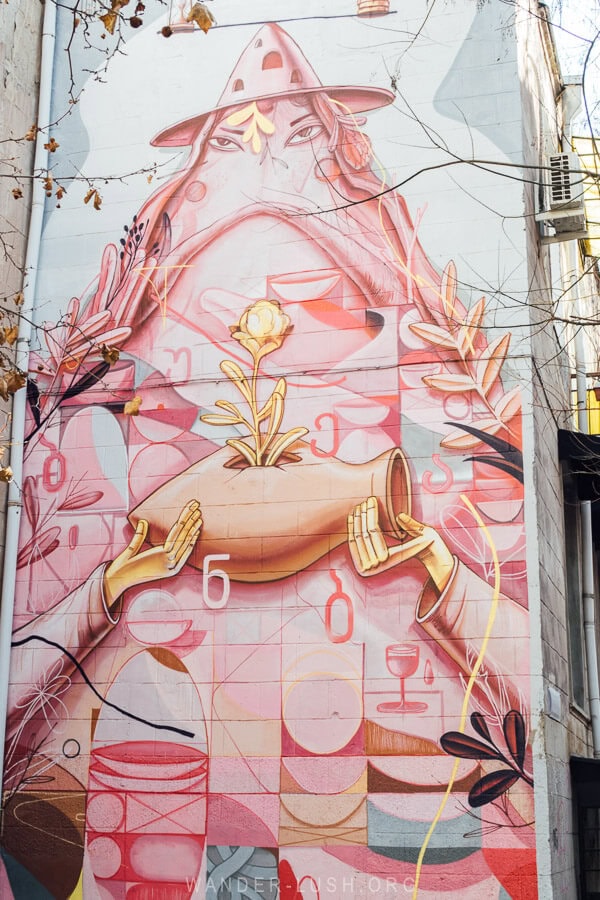
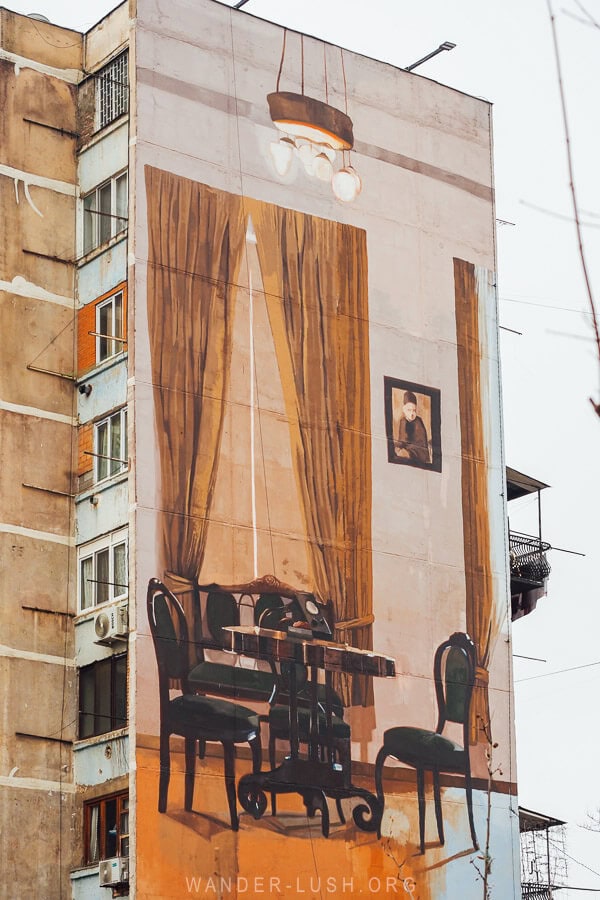
Perhaps the country’s most prolific street artist, LAMB has a style that is instantly recognisable and uniquely Georgian (khinkali feature heavily in his graff). You’ll notice LAMB’s comical and often subversive work all over Tbilisi and as far afield as Batumi and Yerevan. Check out this interview with Mishiko Sulakauri (AKA LAMB) and keep an eye out for his works, especially when you’re travelling through Tbilisi’s underpasses.
18. Go on an urban hike in the hills around Tbilisi
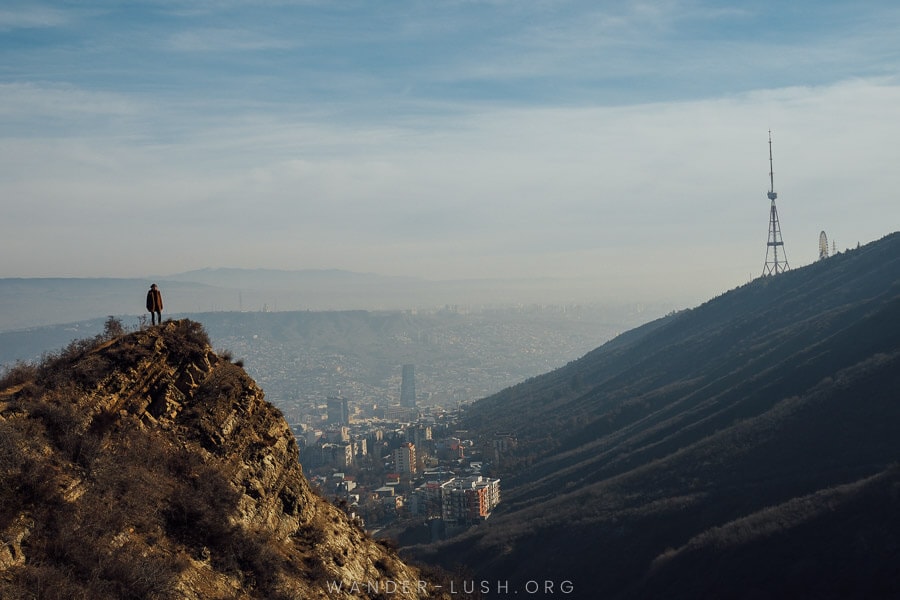
Urban hiking is a great activity for any season. In spring, you can search for red poppies and forage for wild asparagus; in summer, you can retreat to the hills for a break from the hot and humid city air; in autumn, you can bask in incredible fall colours; and in winter, you can frolic in freshly fallen snow.
There are marked trails in the hills and valleys all around Tbilisi. Many of the trailheads are accessible by foot or by using public transport from the city centre.
The most popular day hikes in Tbilisi include:
- Turtle Lake to Mtatsminda Park
- Kojori to Tbilisi City
- Sololaki to the Tbilisi TV Tower
If you’re looking for a more casual stroll, head to the National Botanical Garden, which is set in the gorge behind the sulfur baths. This vast green space isn’t as impressive as the Botanical Gardens in Batumi, but there are a few marked paths here of varying lengths and difficulty levels.
19. Admire the gravestones at Mtatsminda Pantheon
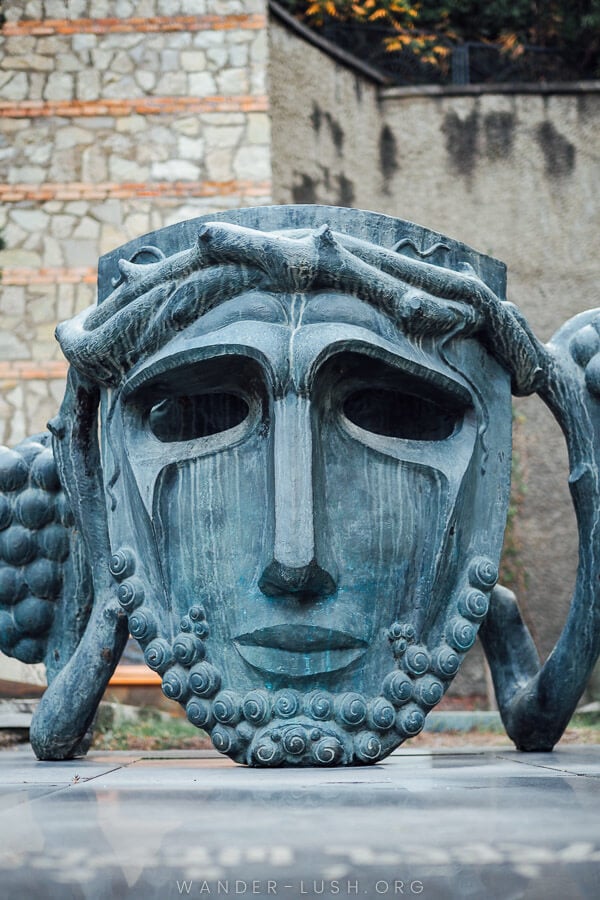
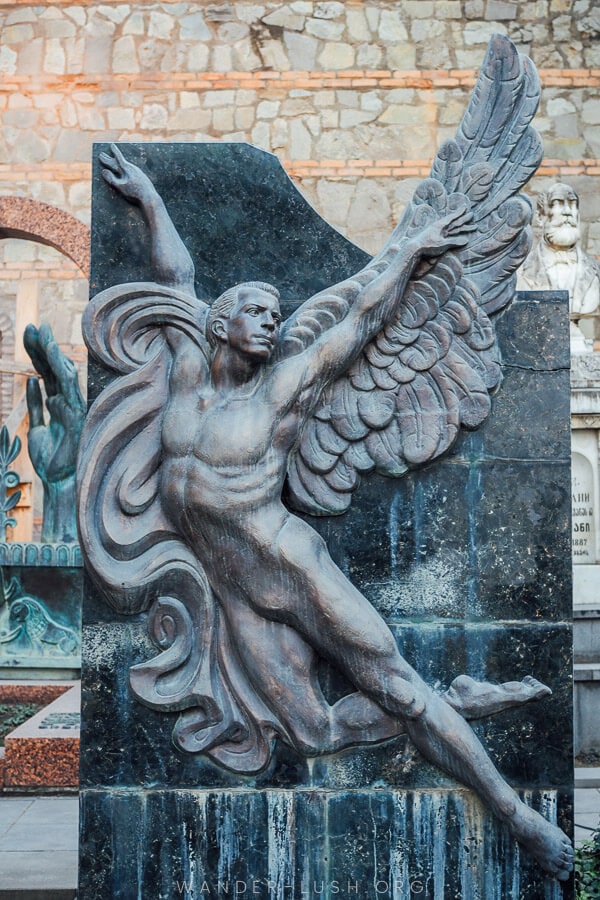
For a quick (but steep) walk via a paved road, follow Mama Daviti Rise halfway up Mount Mtatsminda, aiming for the Tbilisi TV Tower. Not only will you be rewarded with fresh air and an amazing panoramic city view, you’ll also have a chance to explore what has to be my favourite unique attraction in Tbilisi: Mtatsminda Pantheon.
Mtatsminda Pantheon is a historic cemetery that serves as a final resting place for some of Georgia’s most important artists, poets, writers, and historians. Each marble headstone in the necropolis is completely unique and inspired by the career of the individual it commemorates. Some are understated, while others are downright flamboyant.
You can alternatively reach the Pantheon by riding the Tbilisi Funicular to the middle station. If you’re into Tombstone Tourism, interesting gravestones can also be found at Didube Pantheon, and inside Tbilisi’s oldest cemetery, Kukia.
20. Ride the Tbilisi Metro

The Tbilisi Metro System was constructed over a decade-long period starting from 1952, when the city’s population was just shy of the one-million-person threshold required to justify a rapid transit system. Nevertheless, the first six-station line was inaugurated in January 1966, making this the fourth underground built in the former USSR (after Moscow, Saint Petersburg and Kyiv), and the first in the South Caucasus region.
Now with two intersecting lines and 23 stations, the metro is a very convenient way to travel around the city. Especially since a single ride only costs only 1 GEL (around 35 US cents). More than that, the metro is a part of Tbilisi’s identity. It’s a thrilling experience – even if the station escalators and trains do go a little too fast for my liking!
Unfortunately, Tbilisi’s underground stations were never lavishly decorated like the ones in Tashkent, Moscow or Kharkiv – but you can spot some thoughtful flourishes here and there, including bas-relief sculptures and mosaics.
Noteworthy stations include:
- Technical University (mosaics)
- Rustaveli (the deepest station in Tbilisi, with a 120-metre-long escalator)
- Isani (mosaic panel)
- Ghrmaghele (railway-inspired sculpture)
- 300 Aragveli (metal bas-relief)
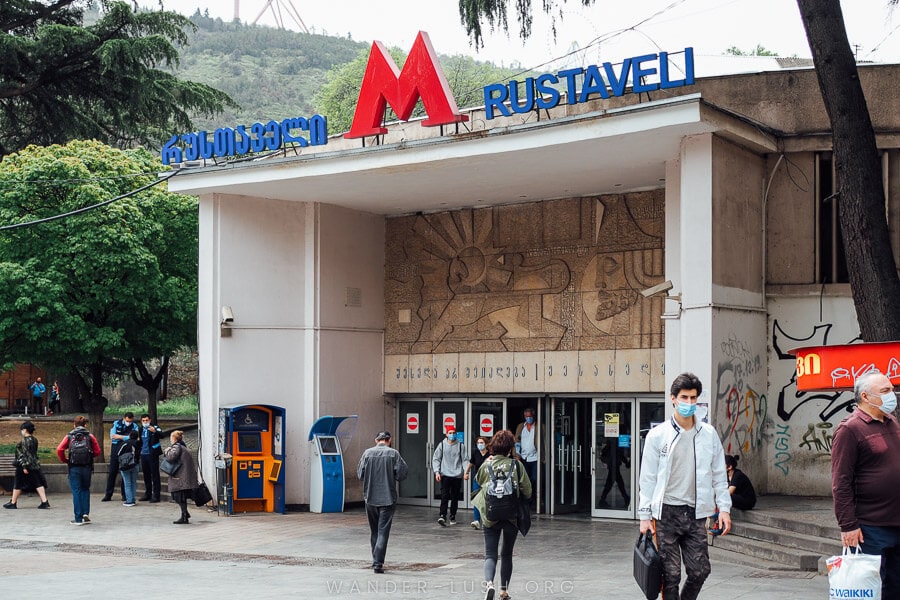
Interesting things happen when you use public transport in Georgia. In Australia, we might call them random acts of kindness. In Tbilisi, these sometimes grand but often unnoticed gestures seem to be part of the everyday social fabric. Where else in the world would you happily hand your wallet or handbag over to a complete stranger?
Just remember that photography is technically not allowed inside the underground stations, which are still classified as ‘objects of strategic importance’ – so you might get reprimanded by the security guard if you whip out your phone.
Best things to do in Old Tbilisi
Old Tbilisi or Dzveli Tbilisi is the most well-trodden part of the city. Here are a few more of my favourite things to do in the historical centre.
21. Stretch your legs on the Betlemi Street Stairs
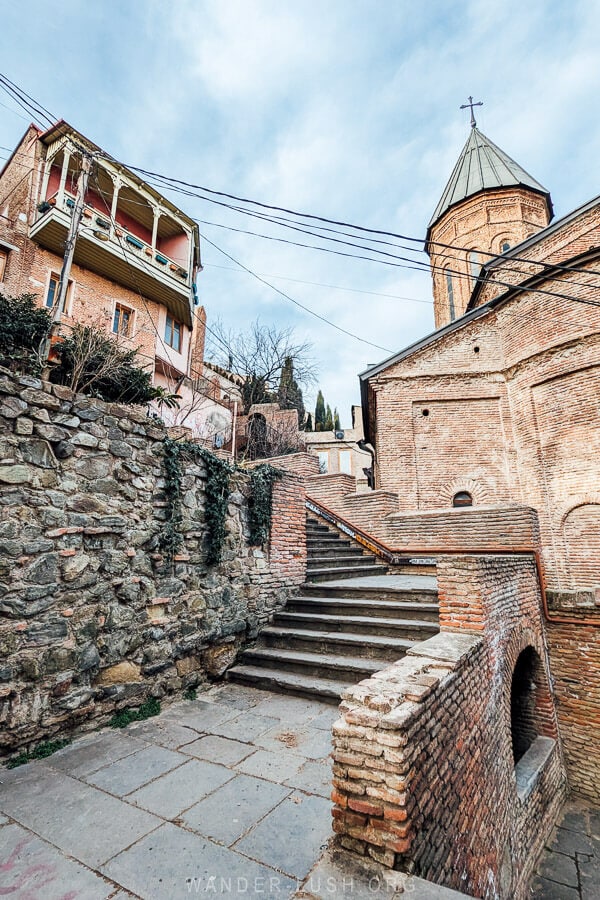
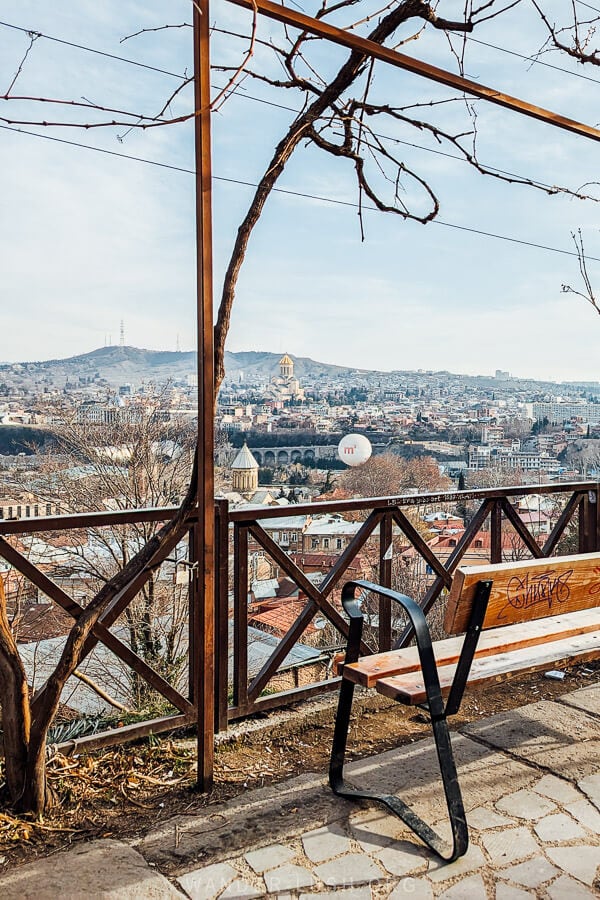
It won’t take long before you realise that Tbilisi is very hilly. In the past, the steep streets of Kala were even more difficult to navigate – hence why enterprising locals decided to connect the upper and lower parts of the city with sets of stone steps.
Designed in 1850 by architect Timote Beloi and financed by the city’s craftsmen guilds or Amkaris, the Betlemi Street Stairs run from Sololaki to Upper Betlemi Church, then on towards the Mother of Georgia statue (see #22 below).
At the top of the stone stairs, there is a sprawling garden that looks out over the city and the top of a church. The Betlemi Rise Viewpoint has plenty of bench seating under shady vines. You’re bound to make a few furry friends up here, as lots of cats call this park home.
From there, you can continue up the metal stairs behind the church to reach the top of the hill, or take the path down the opposite side to get back to the heart of Old Tbilisi.
22. Meet the Mother of Georgia
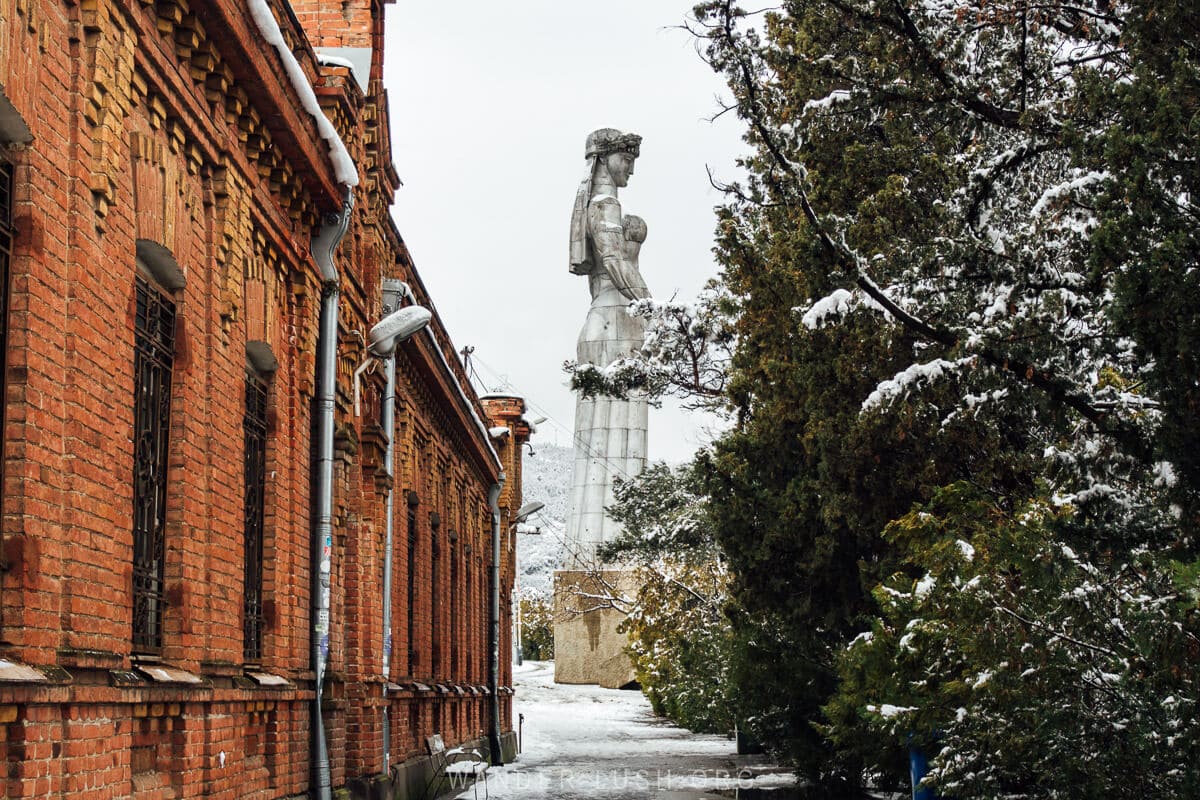
If there were one landmark to symbolise Tbilisi, it wouldn’t be the Peace Bridge or even Narikala Fortress: It would be Kartlis Deda, the Mother of Georgia. A monolithic aluminium statue that stands guard over the city from the top of Sololaki Ridge, she brandishes a sword in one hand (to meet her enemies) and a bowl of wine in the other (to greet her guests). Wine or die!
Erected in 1958, the original monument was designed by Elguja Amashukeli and crafted from wood. A few years later, it was covered with aluminium. Despite its Soviet connotations (you can find similar statues in Yerevan and other cities across the former USSR), Kartlis Deda endured as an emblem of the city following Georgia’s independence. In 1997, a new statue was created to replace the old one.

When visiting the popular Narikala Fortress, don’t forget to make a quick detour to get up close and personal with Kartlis Deda. If you are travelling with a drone, there is a great opportunity to fly directly behind the statue and see the city from her perspective.
23. Track down the Zoroastrian Fire Temple
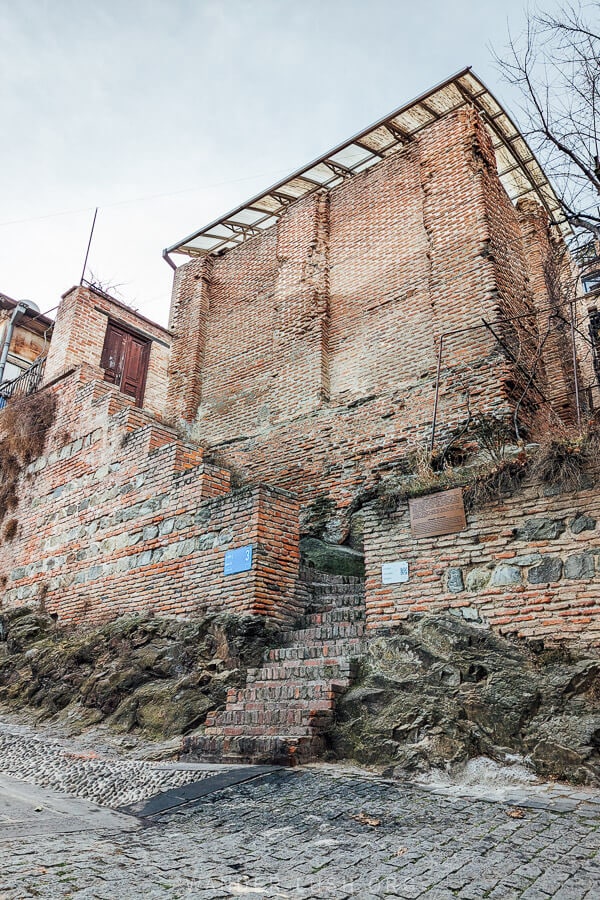
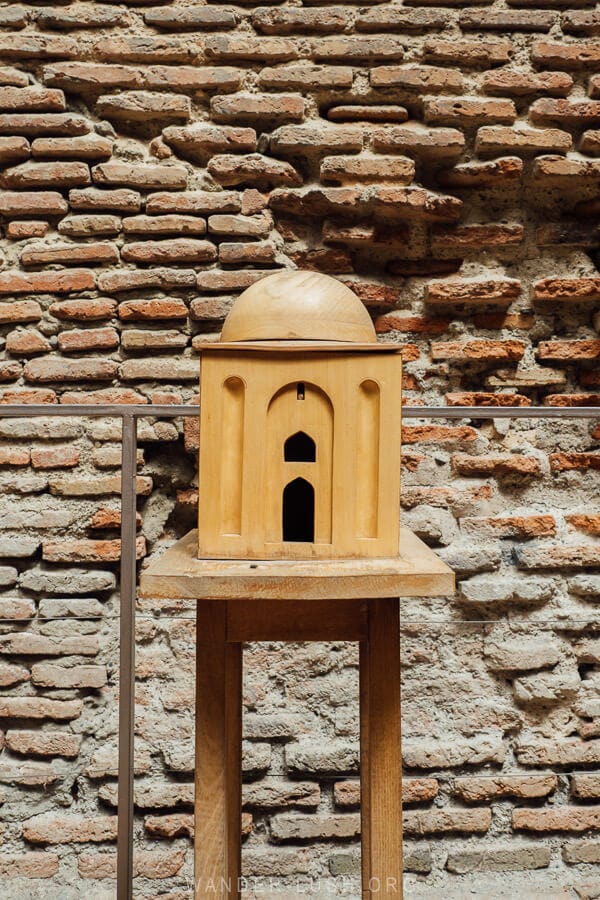
Tbilisi is a melting pot of different traditions and beliefs. Alongside its Orthodox, Apostolic and Catholic churches, synagogues and a mosque, the city also has a Zoroastiran Fire Temple.
Normally it is neighbouring Azerbaijan that is associated with fire worship, but one of the world’s oldest religions was also practiced right here in Georgia. Ateshgah was built some time between the 5th-7th centuries when there was a heavy Persian influence in the city. Having survived the 1795 invasion that destroyed most of Tbilisi, it is one of the oldest – if not the oldest – structures in the city.
The temple, a humble brick structure with a plastic roof, is no longer active. In fact, it’s located inside a private courtyard. If you want to go inside, you will need to knock on the door – someone is usually home to let you in. This wooden model of the temple building is located inside, along with some archival photos.
24. Find the secret church on the Mtkvari River
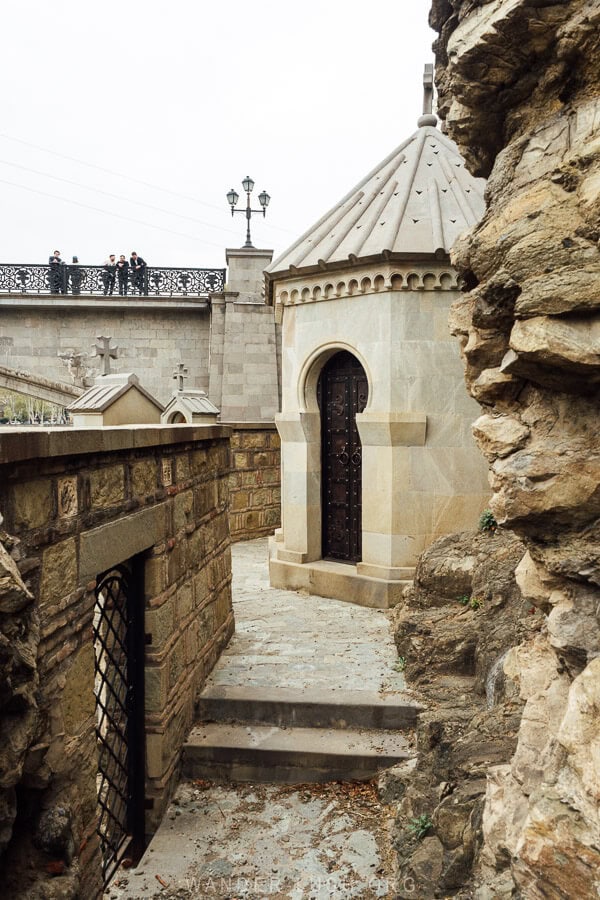
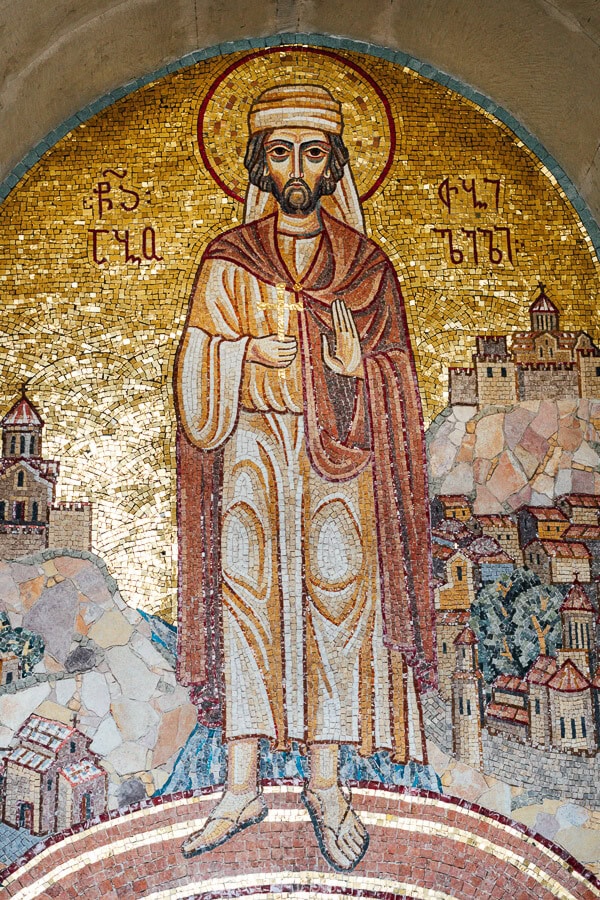
Of the dozen or so churches in Tbilisi that I recommend popping into if you’re nearby, this tiny chapel on the riverside has to be my favourite. It took me many years to learn of its existence, and a while longer before I finally managed to get inside. My persistence finally paid off.
Pressed into the rocky footings of Metekhi Rise, directly opposite the sulfur baths, the Church of Saint Abo Tbileli is hidden in plain sight. As you descend the stairs down to the water’s edge, you will see a set of wayside shrines buttressing a small balcony that hangs over the churning river.
A second oratory houses a gold-hued mosaic of a turbaned Saint Abo, the perfumer from Baghdad who accompanied Prince Nerses to Georgia in the 8th century and preached Christianity amidst the Saracen raids. After refusing to renounce his newfound religion, Abo was gruesomely martyred by the ruling Persians in 786, and his remains cast into the river at the spot where his church now stands.
25. Stand in the belly of an abandoned Armenian cathedral
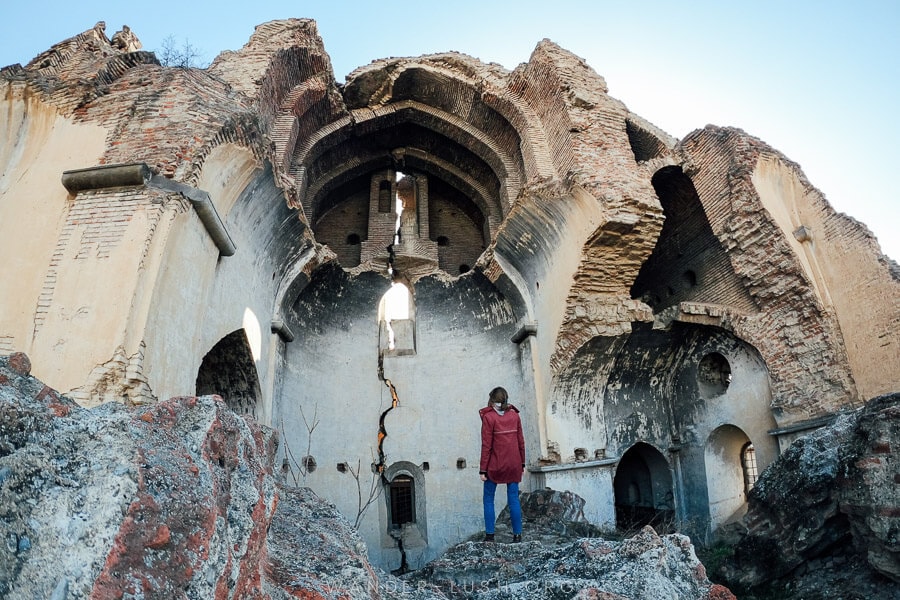
Shamkoretsots Astvatsatsin (AKA Karmir Avetaran Church or the Church of the Red Gospel) was the tallest Armenian Apostolic church in Tbilisi when it was completed in 1809. After a robbery and a failed restoration attempt, it shut its doors to parishioners in 1937.
The church was then repurposed as a bakery, but apparently the dough mysteriously refused to rise. Later on, it was used as a gym, and then as a library, before eventually housing artists’ studios. In April 1989, the church almost completely collapsed in the days following an earthquake. The cupola and western facade were destroyed, leaving part of the cathedral open and exposed.
You can climb into the belly of the church from the adjacent car park. The whole area is scattered with bricks and debris, and a huge crack rises up right through the centre of the ruins. Like so many other buildings in Avlabari, Tbilisi’s historic Armenian Quarter, it is both magnificent and melancholy.
26. Do a spin on Queen Darejan’s balcony
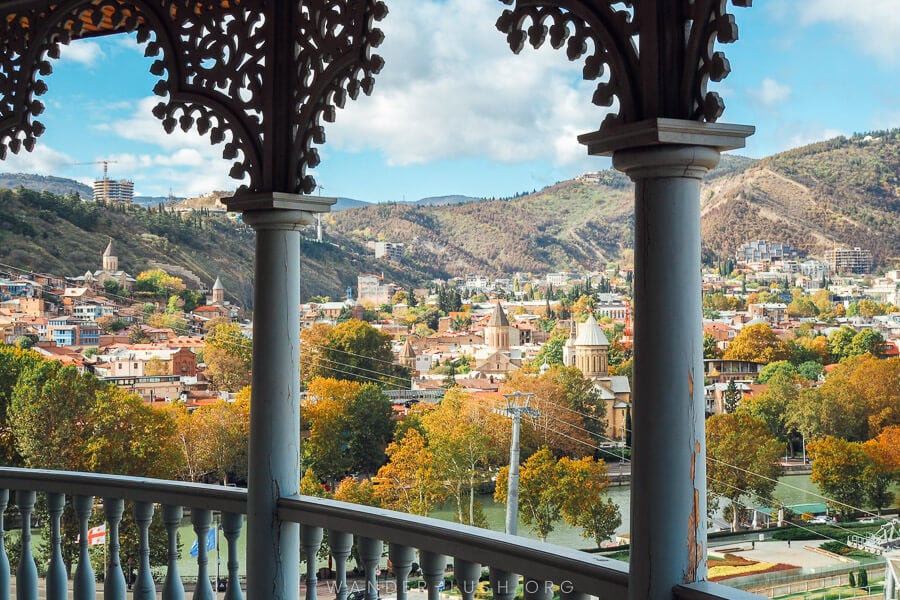
Also in Avlabari, just a few blocks from Karmir Avetaran back towards Metekhi Church, Sachino Palace is a must see in Tbilisi, but a place many people skip. The rounded baby-blue balcony here is fit for a princess – or in this case, a queen.
Erected in 1776 atop the ruins of the 11th-century Isani Fortress and one of Tbilisi’s old city gates, it served as a summer residence for the Queen Consort of Kartli-Kakheti, Queen Darejan. The mother of all Tbilisi balconies was recently restored and repainted, and the pretty yard enclosed by high walls replanted with wisteria vines that explode with purple flowers in early April.
As you climb Wine Rise from Rike Park, you pass by the moss-clad footings of the palace, perpetually dripping with Queen Darejan’s tears (she was exiled here before being deported to Russia on the grounds of undermining the Russian Empire).
The Holy Lord’s Transfiguration Convent, located inside the palace grounds, is a working nunnery, with a small gift shop here where the Sisters sell their embroidery and lacework.
27. Survey the restored facades in New Tbilisi

Tbilisi might not have the best track record when it comes to caring for its historic buildings. Many of Sololaki’s most beautiful homes have fallen mercy to the underground waterways coursing under the streets, causing gaping cracks to open up in the facades, and stairs and doorways to cave in. It’s amazing to think that some of these buildings are still inhabitable.
In recent years, more and more houses have been added to the list of Cultural Heritage Monuments. New Tbilisi is an ongoing City Hall project that has seen buildings in several parts of Old Tbilisi restored to their former glory.
It started with the facades on the pedestrianised part of Aghmashenebeli Avenue. Atoneli Street near the Dry Bridge Market soon followed, and most recently, all the houses on Lado Gudiashvili Square were remodelled.
The repainted and remoulded facades stand proud, and many of the interior frescoes have been refreshed as well. As the buildings have been given a second chance at life, cafes, restaurants and shops have moved in. But has the soul of the Old Town been lost in the process? You can be the judge.
28. Climb to Tabor Monastery for the best city views
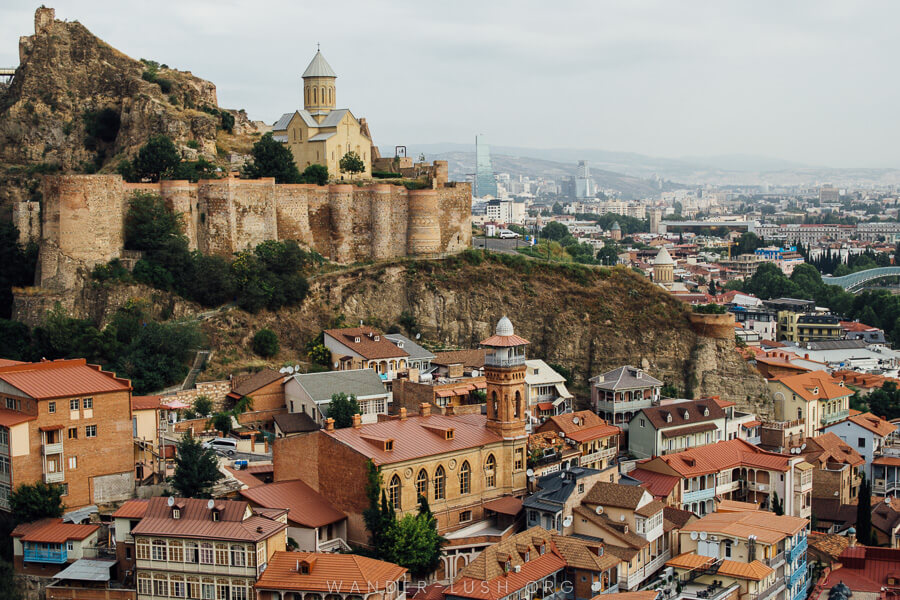
Another thing Tbilisi is definitely not lacking is viewpoints. Funiculars and cable cars link the low-valley downtown with wonderful hilltop lookouts. But my favourite spot of all, the location where I took the photo above, can only be reached on foot.
The Tabor Monastery of the Transfiguration sits directly above Abanotubani and looks out over Narikala, the sulphur baths, and the river beyond – all the way down to the outer suburbs. Capturing both old and new Tbilisi in the one vignette, it gives a good overview of the entire skyline. Every time I visit, the view changes slightly with the addition of new silvery skyscrapers in the distance, and old buildings vanishing from the foreground.
To get there, start from Maspindzelo restaurant on the riverside, and follow Firdousi Street then Bazovi Street (fair warning: these streets are made from sleek riverstones and are extremely steep!). When you reach the dead end (at this point), use the small concrete steps to reach the new metal staircase. This will bring you to a brand new pathway that runs along the ridge to the monastery.
There are several viewing platforms along the way – but note that the plateau area (where I took my photo) might be fenced off pending construction. The whole area seems to be under development now, and will no doubt be covered with apartment buildings in a couple of years. For the time being, you can still enjoy the view in peace.
Best things to do in Tbilisi for foodies
Here are my favourite activities and experiences that revolve around food and drink.
29. Shop for spices at the Dezerter Bazaar
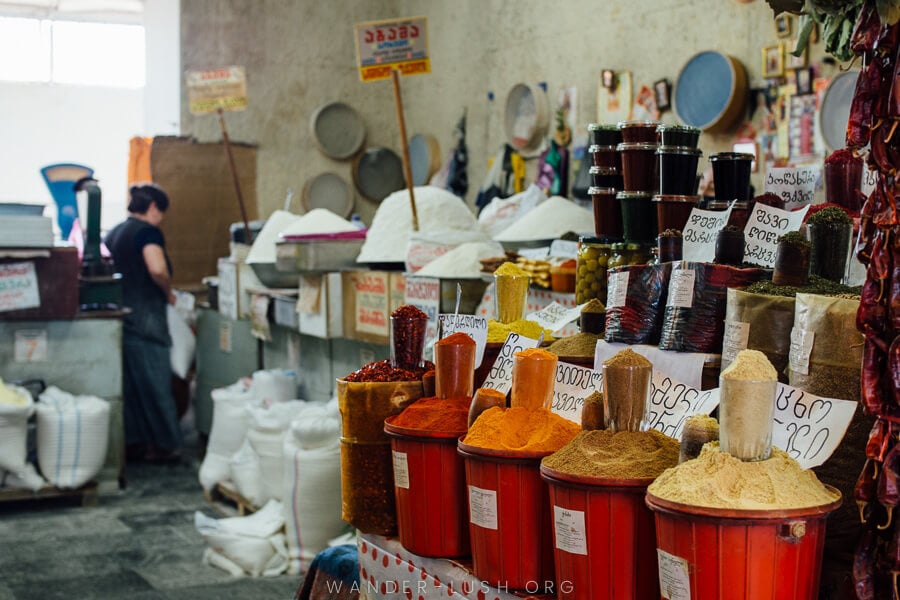
There are few things I love more than a good local market – and lucky for me, Tbilisi has plenty to browse through. The Dezerter Bazaar might not be the prettiest fresh food market (Kutaisi’s Green Bazaar is much more photogenic, I must say!), but it is certainly brimming with gritty character.
An infinite number of stallholders converge on this indoor-outdoor market and the surrounding streets every morning, trading everything from sulguni cheese, pickles and mountain honey, to spices, herbs, cornflour, and fresh fruit and veg.
The market has a fascinating history and is in many ways the epicentre of the city. That’s why news that the area would be cleared to make way for a modern shopping mall was met with cries of outrage from many people. Those plans have been tabled for now, but the future of the Dezerter still hangs in the balance.
A morning at the bazari will give you a little taste of Tbilisi’s food culture, and a hint as to what seasonal ingredients you should look for when ordering from restaurant menus.
30. Take a cooking class with Georgian Flavors

If you fall in love with Georgian food and want to try your hand at whipping up a few delicacies, this activity is for you. I spent years searching for a good hands-on cooking class in Tbilisi, and finally found one in Georgian Flavors, a boutique company run by my friend and food guru, Irma Laghadze.
Irma runs private and small-group masterclasses at her gorgeous home kitchen in central Vake district, plus special workshops in Kakheti and Imereti. During the Tbilisi cooking class, you’ll learn all about Georgia’s culinary history while preparing four dishes, then enjoy a sit-down lunch with wine.
You might not be cooking khinkali and khachapuri, though: Irma’s aim is to introduce visitors to Georgia’s best regional and seasonal dishes, including special foods from her native Kutaisi.
31. Try Shotis Puri fresh out of the Tone

Made from wheat flour and shaped like a tiny, delicious little canoe, shotis puri bread is an extremely simple table staple that is served with every meal (no exceptions). When it’s done well (and served hot), it’s difficult to beat.
Just about every city block has its own shoti bakery – usually located underground – with a traditional round clay oven called a tone. Batons of sticky bread dough are slapped onto the slides of the oven and come out with a crispy, crunchy, salty bottom. There are no plastic bags in sight: The baker will offer you a piece of paper (maybe a square of newspaper or a recycled page of notepaper) to protect your hand from the piping hot bread on the walk home.
At just 1.20-1.50 GEL a piece, puri is a nice on-the-go snack when you’re pounding the pavement in Tbilisi. Some bakeries also serve lobiani (bread filled with mashed kidney beans) and nazuki, a sweet version of puri with cinnamon and raisins.
32. Taste Georgian tea at the Bitadze Tea Museum

Under Soviet rule, Georgia become the world’s fourth-largest producer of tea – the continuation of a legacy established by a Gurian prince much earlier in 1809. The industry all but collapsed in the 1990s – but today, a growing number of teatrepreneurs are reviving forsaken fields and factories in Western Georgia’s Guria, Imereti and Adjara regions.
As leaders of the Tea Growers Association, the Bitadze family know everything there is to know about Georgian tea. Their tiny shop-museum in Sololaki doubles as a tasting room, where you can sample local black teas, green teas, and fruit teas. Loose leaf teas are available to buy as well.
Giorgi Bitadze is at the shop most days, and will gladly guide you through the exhibits of old tea boxes and archival photos that he and his father have lovingly curated.
33. Drink specialty coffee at one of Tbilisi’s roastery-cafes
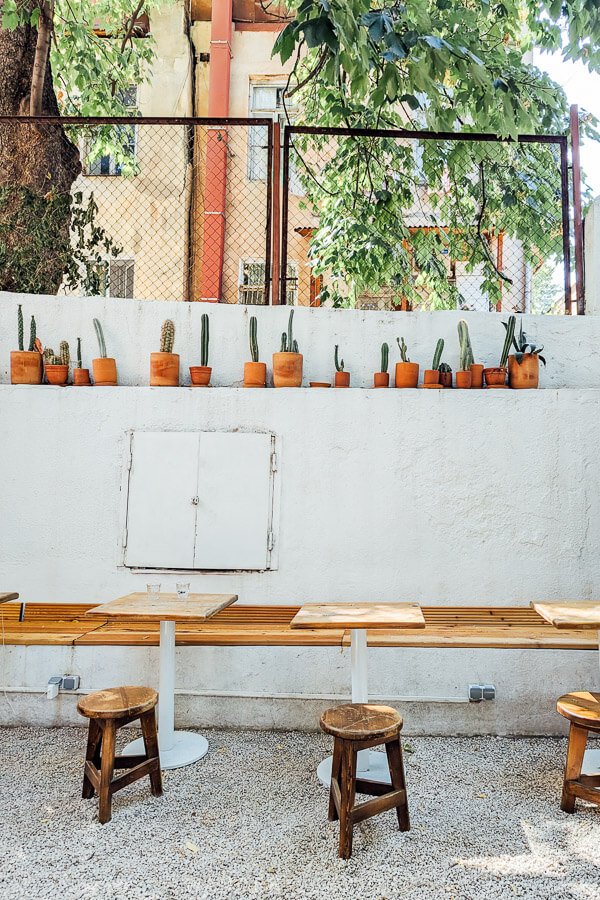

When I first moved to Tbilisi, the coffee scene was pretty bleak. That has changed in a big way over the past 36 months, with a score of specialty cafes opening up around the city – several of which roast their own beans in-house.
Tbilisi’s coffee scene is very interesting. You will often find unusual items on the menu – personally I had never tried infusions or RAF coffee before arriving in Tbilisi – imported from different countries by coffee entrepreneurs.
My favourite specialty cafes in Tbilisi include:
- Coffee LAB, Tbilisi’s original cafe-roastery, with a dozen branches around the city
- Shavi, my favourite coffee in Tbilisi, now with four branches
- OKRO Roastery, a relatively new roastery-cafe in Vera
34. Eat a workers’ lunch at a sasadilo canteen

There was a time when sasadilos or workers’ canteens could be found all over Tbilisi. Catering primarily to factory staff, they were known for their no-frills style of dining, and old-fashioned home cooking.
As a big fan of Cong Caphe in Hanoi and Radio Bar in Tirana, I always thought it would be brilliant if someone started a cafe-restaurant that referenced Tbilisi’s Soviet history. Finally it happened in 2024 with the launch of Sasadilo Zeche.
Located in a warehouse building (part of an old tobacco factory) close to the Dezerter Bazaar, Zeche features retro decorations including USSR-era relief sculptures and PSA posters. The paper pick-and-tick menu by chef and food technologist Luka Nachkebia includes hearty dishes such as kebabi, kofte, and Georgian stews, plus inventive items such as bao buns stuffed with beans, lobiani-style. For something different, try the Ajarian chirbuli, which is similar to a shakshuka but made with walnuts.

If you want the real deal, Sasadilo Coca-Cola is a Tbilisi foodie experience that’s hard to match. This Soviet-era cafeteria opened in the 1990s to cater to workers from the nearby Coca-Cola bottling plant, and I don’t think the owners have changed a single thing about it since!
I first came here in 2017 on the recommendation of my host in Tbilisi. What an excellent suggestion that was. The fit-out is as retro as it gets, and the atmosphere is unique to say the least – a bottle of vodka or cognac seems to be the standard order, and it does get rowdy by about 2pm!
Staff don’t speak much English, and the menu hanging above the counter is all in Georgian, but it’s easy enough to piece together a feast with hand gestures. Mtsvadi, kharcho and other standard classics are all priced at 10-15 GEL. Small plates of pickles, salted fish and Imeretian cheese can be collected from the cold cabinet at the front. Cash only.
35. Sip chacha cocktails in a historic pharmacy

Tbilisi’s cocktail scene has similarly come along in leaps in bounds, and there are now a dozen excellent cocktail bars around the city. None of them have a story as cool as Apotheka Bar and Lounge, though.
Created by the Georgian celebrity chef Tekuna Gachechiladze, Apotheka opened in late 2024 and breathes new life into one of the city’s oldest pharmacies, which was still trading as a drug store up until a few years ago.
The new fit-out is quite glam, but the memory of the building’s OG patron, pharmacist Ferdinand Otten, has not been forgotten. Ceiling frescoes and wall paintings that depict different medicinal herbs were uncovered during the renovation and expertly restored, while the original 1902 timber drug cases have been repurposed as liquor cabinets. Cocktails with names such as Penicillin and Vitamin C are crafted by mixologists dressed in white lab coats.
Georgia has quite a fascinating history when it comes to pharmaceuticals, folk remedies and modern medicine – learn more at the Museum for the History of Georgian Medicine for more.
36. Grab a plate of ponchiki donuts at Cafe Funicular
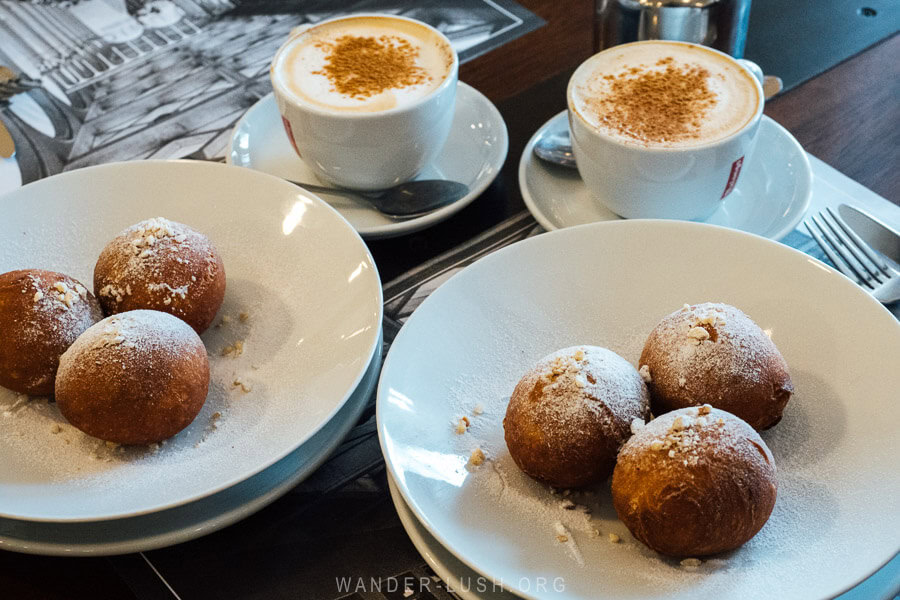
Built atop Mtatsminda ‘Holy Mountain’ in 1938, the Upper Funicular Station Building and its restaurant have been a local institution for decades. As someone once told me, going up to Mtatsminda to eat ponchiki (puffy donuts filled with cream) was a big treat during Soviet times, and still conjures happy childhood memories for many Tbilisians.
There is a casual cafe on the bottom level of the funicular station where you can buy these sweet treats by the plate. The ponchiki are served with a dab of vanilla, chocolate or pumpkin pastry cream inside. I recommend going up for sunset and eating outdoors – the view from the terrace is wonderful.
37. Feast on Abkhazian cuisine at Amra
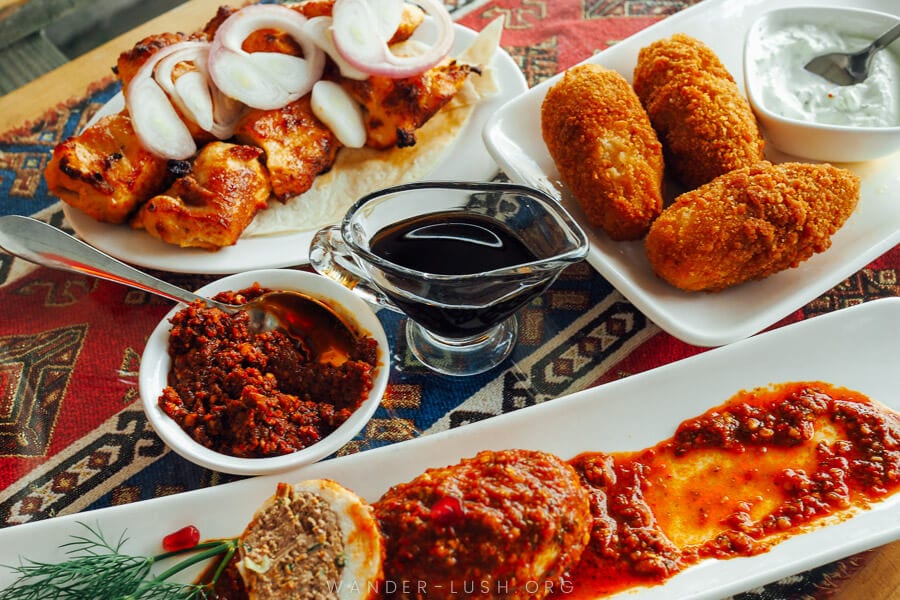
Most people won’t get a chance to visit the Autonomous Republic of Abkhazia on Western Georgia’s Black Sea coast, but that doesn’t mean you have to miss out on the region’s incredible cuisine.
Amra was a popular restaurant in the Abkhazian capital of Sokhumi until the 1992-3 war forced the owners to flee their homeland. They relocated to Tbilisi and reopened their popular restaurant, bringing authentic Abkhazian and Mingrelian recipes to Saburtalo district.
Abkhazian fare is unlike anything else you’ll eat in Georgia. If you’ve been missing spicy food, this is your Hail Mary. It makes heavy use of ajika, a fragrant and fiery spice blend (there are around 70 different varieties of the stuff, ranging from dry rubs to pastes). I highly recommend the ajika-crusted chicken, the ajika burger, and the ajika-stuffed egg – and to cool off afterwards, a Sokhumi ice cream sundae, served with tangerine jam and crushed nuts.
38. Try spicy-cold Ajika ice cream at The Cone Culture

My favourite ice cream shop in Tbilisi, The Cone Culture does a fun take on Georgia’s beloved spice blend. Originally conceived for a food festival in Zugdidi, their ajika ice cream blends the fiery pepper mix with vanilla bean or chocolate for a super fragrant, tongue-tingling, hot-cold treat.
If piquant ice cream isn’t your style, they also do the classics, plus imaginative flavour combinations that use local and seasonal ingredients: apricot and tarragon, black tea and brownie, and orange and cloves, to name a few.
39. Drink Lagidze Water from the fountain

Georgia is the birthplace of wine, and a dark horse when it comes to tea. The country also a growing craft beer and cider scene – and then there’s the legendary mineral waters, Borjomi, Nabeghlavi, and friends. Well, another beverage that the country does extremely well is natural lemonade.
Invented in Kutaisi by a young pharmacist named Mitrofan Laghidze in 1887, Laghidze Water was designed to be a healthier alternative to sugary soft drinks. The drink is made with natural syrup and is a bit like an egg cream soda. Popular flavours include tarragon (which is neon green in colour), quince, chocolate, and my personal favourite, cherry.
You can buy Laghidze Water in bottles from the supermarket, but the traditional way to imbibe is straight from the fountain. There are numerous restaurants and cafes in Tbilisi (including Puri Guliani and Amo Rame) that still serve Lagidze the old-fashioned way.
Laghidze also have a stand inside Bazari Orbeliani, a gourmet food court (think the Time Out Market) and shopping hub that launched a few years ago inside a historic 1886 market hall.
40. Treat yourself to a royal sweet at Cafe Leila
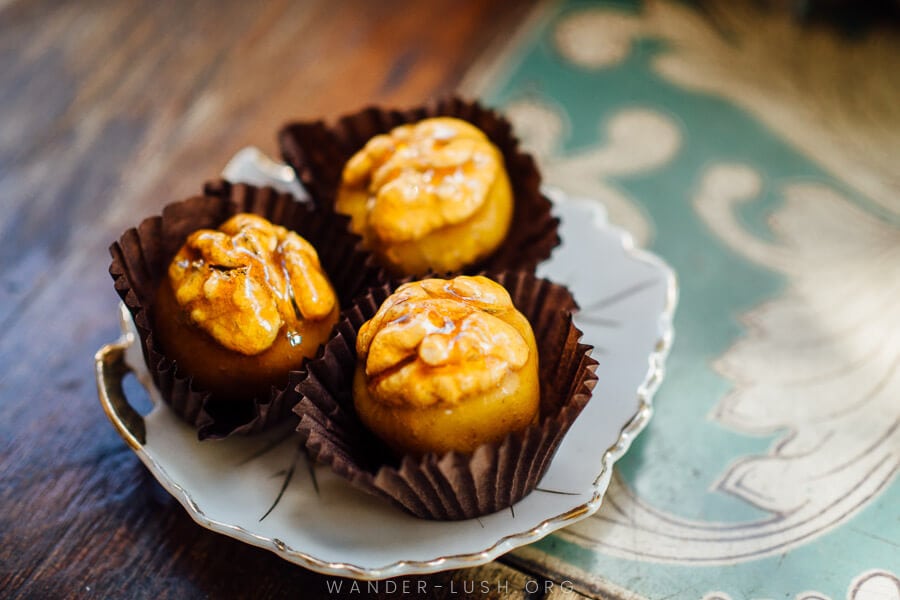
In a country where desserts are not all that common, Orbeliani’s Royal Candy or kaklucha is an exceptional example of a Georgian sweet.
Named after the poet and sweet-tooth for whom it was invented, Vakhtang Orbeliani, the candy is made according to an age-old and closely guarded recipe. And it’s only served at a handful of cafes in Tbilisi, including Cafe Leila.
These bite-sized candies have a super-soft walnut interior. The paper-thin caramelised sugar coating snaps like a toffee apple, while the addition of a whole walnut in the middle gives them even more texture. Yum.
Alternative things to do in Tbilisi for Soviet history
Tbilisi is a playground for urbexers and photographers who are intrigued by Soviet history. Here are my favourite Soviet throwbacks.
41. Educate yourself at the Soviet Occupation Hall
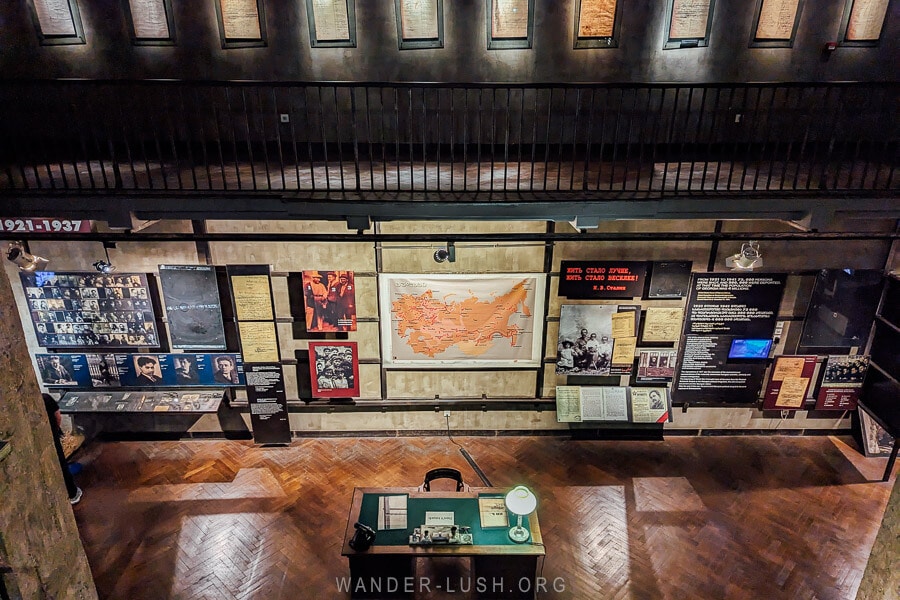
It’s impossible to visit Georgia without brushing up against Soviet history. I recommend all visitors take the time to learn how this harrowing period impacted the nation and its people.
Set on the top level of the Georgian National Museum, the Soviet Occupation Hall is a permanent exhibition that addresses this Soviet regime in Georgia. The single-room exhibit runs visitors through a detailed timeline of events from independence in 1918 to the Red Army invasion of 1921, right up to the dissolution of the USSR and beyond. Photographs, journal entries and personal ephemera help to humanise the history. Didactics are in English, but are limited.
Another museum worth visiting for an insight into this epoch is the Museum of Repressed Writers, located inside the Writers’ House of Georgia.
42. Visit Stalin’s Underground Printing Press
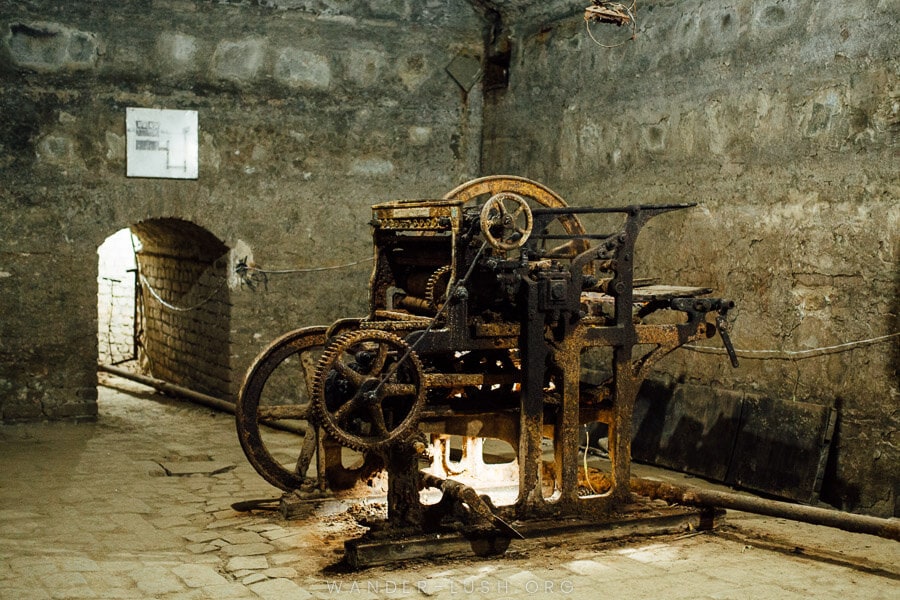
Given that Joseph Stalin was born in the nearby city of Gori, he unsurprisingly left his mark on Tbilisi, too. As a young man, Stalin studied at the seminary off Freedom Square. When he launched into his revolutionary activities, he started printing propaganda materials on a secret typographic machine housed in a basement down a 15-metre-deep well on the eastern side of Tbilisi.
The clandestine hangout was exposed and destroyed in 1906. After the fall of the USSR, it was turned into a small museum. The original press, made in the German city of Augsburg and smuggled into Tbilisi in pieces where it was reassembled, is on display here alongside other ephemera from the period.
Though it’s a twisted pilgrimage site for some, the Underground Printing House Museum nonetheless retells an important chapter of Georgian history. One of the highlights is meeting the museum caretaker, Soso, who is quite a character indeed.
43. Fly over the city on a Soviet-era ropeway

Georgia must be the cable car capital of the world: never in my life have I seen so many ropeways criss-crossing the skies. The Tbilisi Aviation Factory was the USSR’s only manufacturer of cable cars, so it’s little wonder why.
An estimated 75 passenger lines were built across the country starting from the 1950s, the most famous being in Chiatura and in Khulo. By the 1990s, there were six lines in Tbilisi, two of which (Turtle Lake and the Bagebi-Maglivi Cable Car) are still running today, partially on their old Soviet-era machinery.
In late 2024, the Rustaveli-Mtatsminda Cable Car reopened to the public after a long hiatus, bringing the total count of Soviet-era ropeways to three. Its lower station building is exceptionally beautiful.


The Turtle Lake cable car departs from a bottom station adjacent to Vake Park, and is a convenient way to get to the Open Air Museum of Ethnography and Rachis Ubani restaurant. It sails over the park and WWII Memorial, affording a great view of the People’s Monument by Giorgi Ochiauri and Zurab Tsereteli.
The Bagebi-Maglivi Cable Car connects the Tbilisi State University campus in Saburtalo with a set of dormitory buildings on the opposite side of the Vera River Gorge. Studkalaki or ‘Student City’ is a surreal piece of Brutalist architecture that photography aficionados will enjoy.
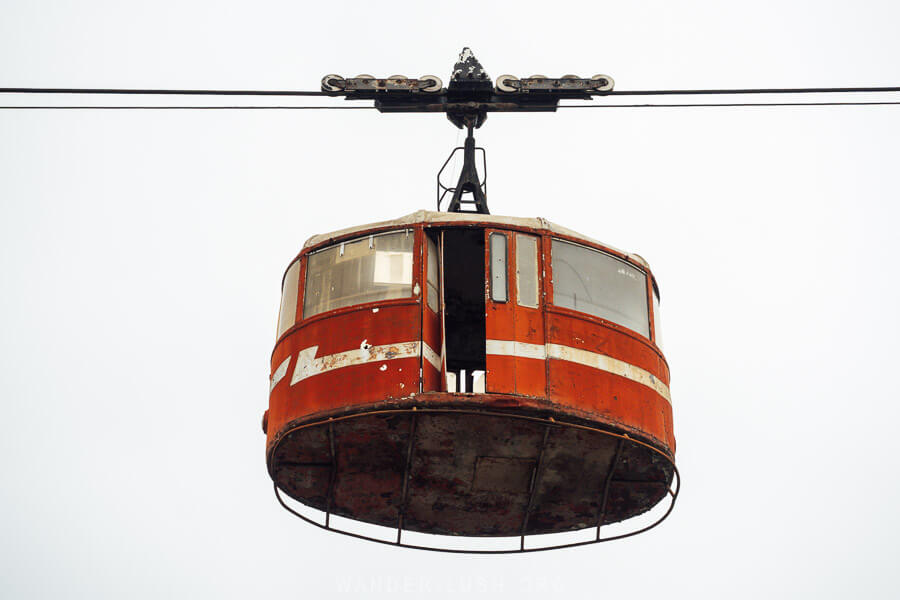
Four more cable cars from the Soviet era – Samgori-Vazisubani, the Mziuri Park Cable Car, Saburtalo-Eliava, and Nutsubidze-Lisi Lake – ceased operation during the electricity crisis of the 1990s. In some cases, their Brutalist upper and lower station buildings remain in-tact.
44. Discover Soviet mosaics and sculptures

Tbilisi is home to some incredible feats of concrete. Monuments, memorials and mosaics erected in the Soviet era add another layer to the city’s already diverse urban landscape.
Fans of concrete, Brutalism and Soviet-style architecture will find a lot to love, from decorative friezes and mosaics to utilitarian Commieblocks.


A few of my favourite mosaics and bas-reliefs include:
- Fabrika bas-relief (8 Ninoshvili Street)
- Wedding House bas-relief (Uznadze Street)
- Former House of Political Education mosaic (61 Aghmashenebeli Avenue)
- Ortachala Fire Station mosaic (34 Gorgasali Street)
- Former Gogilo Bath mosaics (Avlabari)
- Expo Georgia mosaics (Tsereteli Avenue)
45. See the stained glass at the Trade Union Palace of Culture


My favourite building in Tbilisi from the Soviet era is the former Trade Union Palace of Culture. It is located in Saburtalo district, above the entrance to the Delisi Metro Station – yet because of the permanent construction fencing that disguises the facade, most people walk right past it.
Built in 1968-70 by a trio of Georgian architects, the Culture Palace was decorated by Zurab Tsereteli of Chronicles of Georgia fame (see #46 below). The wrap-around mosaic on the exterior is quirky to say the least, depicting a pair of pregnant rabbits worshipping the sun.
The building still functions as an events space. There are several small book shops on the lower levels, thus you can walk inside and pass through unlocked doors without any resistance. The stairwell and wall with bulls and other figures punched out and filled with coloured glass is absolutely spectacular in the right light. On the opposite wall, the same shapes are mirrored in concrete.
46. Venture out to the Chronicles of Georgia
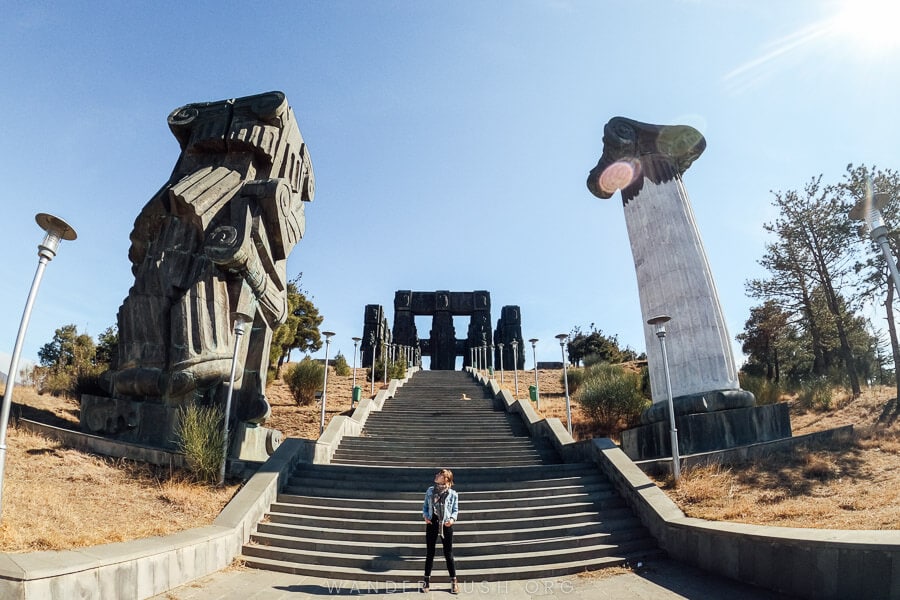
Perched on Keeni Hill above the northern end of the Tbilisi Sea, the Chronicles of Georgia is a sculptural ensemble created by Zurab Tsereteli. Work on the monolith began in 1985 to commemorate 3,000 years of Georgian statehood and 2,000 years of Christianity. But waning funds meant that it would never be fully completed, and scaffolding has always been a common sight here.
Two Greek-style columns mark the main entrance to a colossal concrete staircase. At the top, the main sculpture consists of 16 pillars (arranged in the shape of a cross) that reach 35 metres high. Each one is wrapped in bronze and copper reliefs. There are three horizontal ‘layers’, a triptych that you can read from left to right, with each strata telling a different story.
On the bottom, there are recognisable Biblical scenes. The tall middle band depicts important figures from Georgian history (monarchs, diplomats, poets and writers), and a third level on the outer columns reveals important national traditions such as the Rtveli wine vintage.
Panoramic views of the reservoir and Gldani district (a sea of uniform Khrushchyovka apartment blocks) are another highlight. Visit in the late afternoon for the best light (the monument faces west), or after dark to see the friezes illuminated.
47. Cross the Saburtalo Skybridge
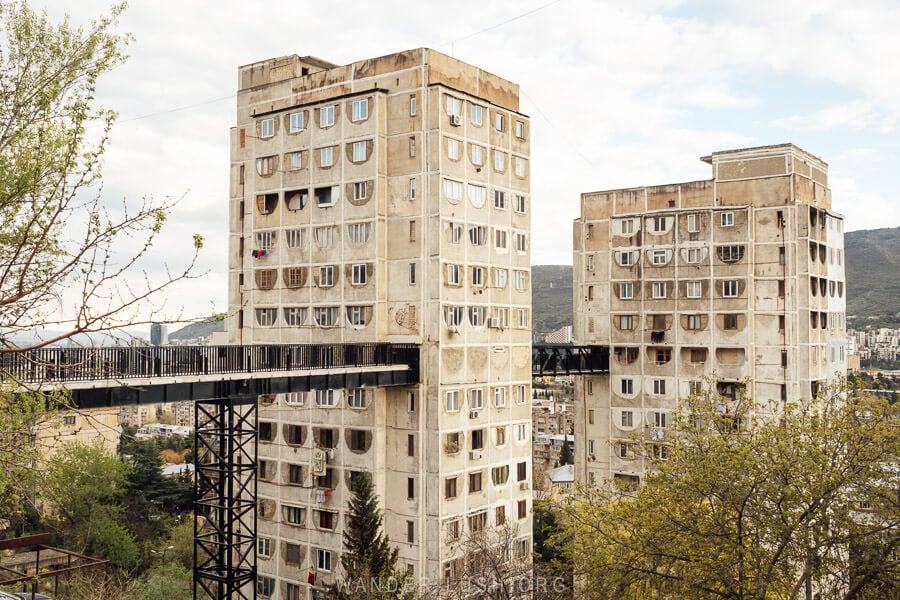
Another example of Brutalist architecture in Tbilisi, the Tbilisi Skybridge (AKA Nutsubidze Skybridge or Saburtalo Skybridge) is one of the most unique buildings you’ll ever experience.
Located on Nutsubidze Plateau, an elevated part of Saburtalo district, the housing complex consists of three 16-floor apartment blocks constructed in 1974-1976 by architects Otar Kalandarishvili and Gizo Potskhishvili. What makes the structure unique is the elevated metal bridges that span the trio, connecting the blocks and acting as a shortcut to ascend the hill.
The bridges used to be a bit rickety, but they were recently repaved and reinforced. To cross, you will need to ride the public elevator from the first building to the top floor. Remember to bring your 20 tetri coins – you will need one per person (not per ride), for both the trip up and the trip back down.


My partners at Friendly.ge host a terrific Soviet Brutal Exploration Tour of Tbilisi, visiting the Skybridge and many of the other landmarks and buildings mentioned here. The tour focuses on storytelling and providing insights into this period of history. It is perfect for photographers and urbexers alike.
Use the code wanderlush to get 10% off when you book the tour using my link.
Things to do in Tbilisi at night
Tbilisi nightlife is so vibrant, it really deserves its own dedicated guide! Here are just a few of my favourite things to do after dark.
48. Soak up golden hour at King Parnavaz Garden (secret Tbilisi sunset spot!)
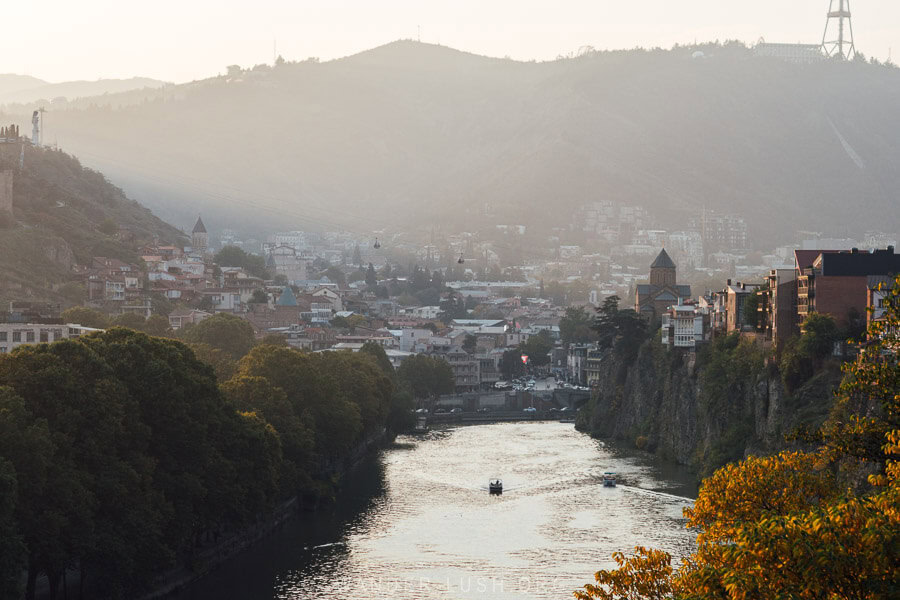
The abundance of hills and gorges around Tbilisi means you never have to go far for a beautiful sunset view. Mtatsminda Park is definitely the most popular spot to watch the sunset – but I have my own favourite spot for golden hour, and you might not have heard of it before.
King Parnavaz Garden is a tiny roadside park in Avlabari district, on the Left Embankment. It sits right at the sweet spot where the Mtkvari River bends, giving you a clear view down to Metekhi and Narikala. You can see the Mother of Georgia in profile, the cable cars running back and fourth between the castle and Rike Park, and from a different angle, the tethered balloon sailing up towards the Tbilisi TV Tower.
The sunset is particularly beautiful here in autumn. I took these photos in October.
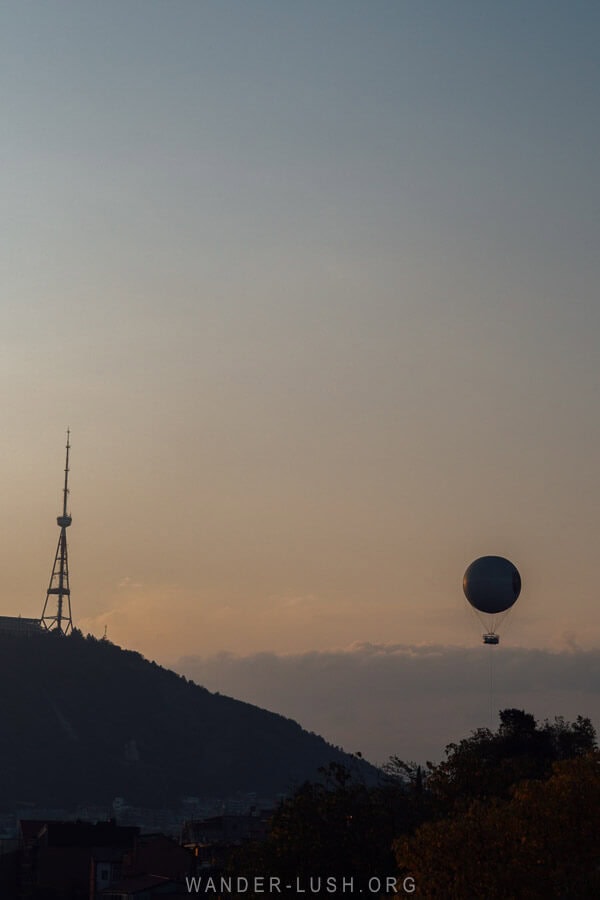
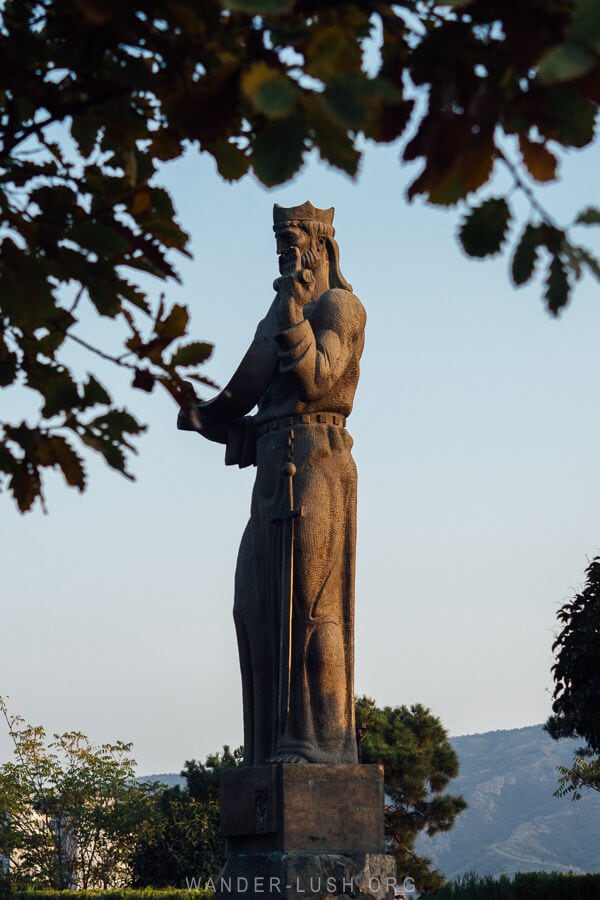
The garden is dedicated to the first man to rule the Kingdom of Iberia during the 3rd century BC, and centres around a giant statue of King Parnavaz. In his giant stone hands, he clutches a scroll – a nod to the fact that he is sometimes credited with creating the first Georgian alphabet.
There are a few locations nearby where you can get similar sunset views: ATI Restaurant on the 10th floor of the Sheraton Hotel is my top pick. In The Shadow of Metekhi, another restaurant that has a balcony right next to King Parnavaz Garden, also had a beautiful outlook.
49. Don your Sunday best for a show at the Opera Theatre
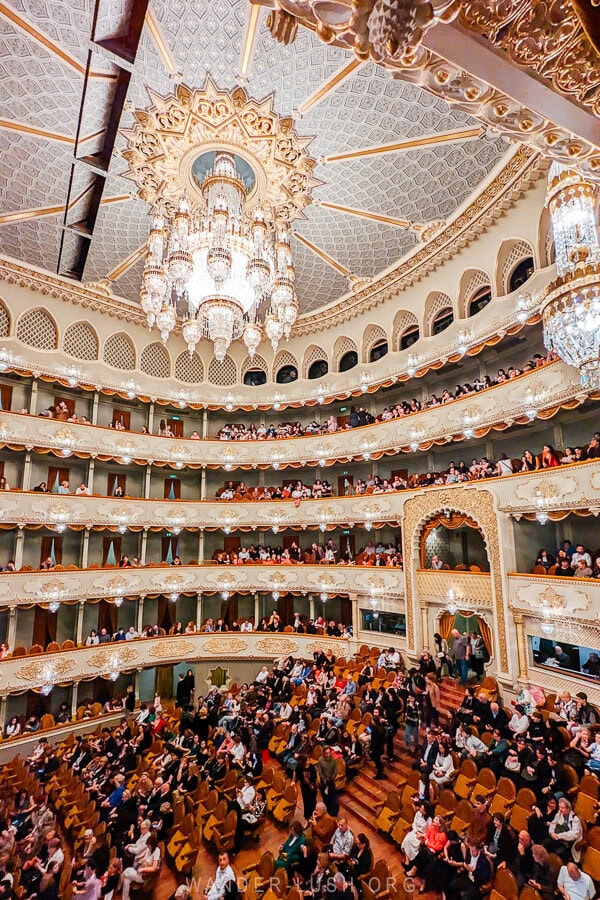

The Opera and Ballet Theatre on Rustaveli Avenue is one of Tbilisi and Georgia’s oldest arts institutions, having been established way back in 1851. While you will find theatre plays, dance recitals and music performances happening all over the city on any given night, the Opera Theatre is really the gold standard when it comes to a night out on the town, Tbilisi style.
I say this, because this theatre has one of the most impressive interiors in the city. Behind the gold-and-burgundy neo-Moorish facade, designed in 1896 by German architect Victor Schroter, the stairwells and halls within feature incredible muqarnas plasterwork, Qajar-style mirror work, and stained glass. It is a true fusion of European and Oriental sensibilities.
Performances of Georgian and international ballets take place throughout the year, especially in autumn and winter. Check the program and buy tickets online through TKT.GE. With prices starting from just 10 GEL, you can even pick up a ticket just to see the foyers. Smart-casual dress is acceptable.
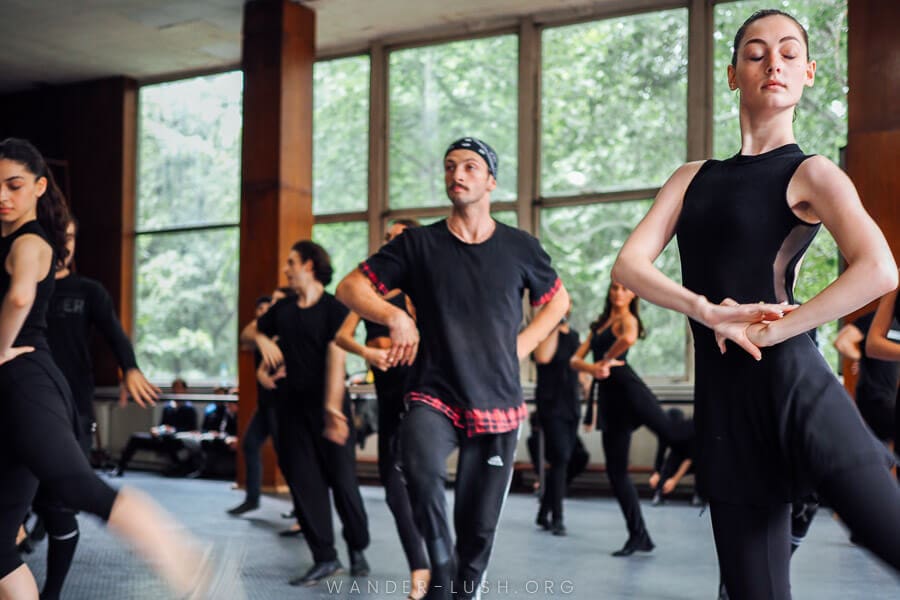
Another major bucket-list item for Tbilisi is seeing Sukhishvili, Georgia’s world-famous national ballet. I have been lucky enough to watch them three times now, including at a rehearsal. The dance troupe blends traditional Kartuli and contemporary dance for a one-of-a-kind show. Dates are announced on their Facebook Page and tickets are sold via TKT.GE – they always sell out fast.
An easy way to see Georgian folk dance (usually paired with folk singing and polyphony) is with a ‘dinner and a show’. Though very touristy, it can be a fun experience. Some venues are more tasteful than others.
50. Go bar hopping at Wine Factory N1

For a selection of cocktail lounges, wine bars and restaurants under one roof – with ample outdoor seating and a great atmosphere – I recommend spending an evening at Wine Factory N1.
Built in 1894-96 by architect Alexander Ozerov, Ghvinis Karkhana was a major centre of wine production during Imperialist and Soviet days. After lying abandoned for some years, it reopened in 2017 as a dining and entertainment precinct.
As well as wine bars, you will find cocktail bars, a slew of nice restaurants (my top pick is Shushabandi), breakfast cafes (I love Mint), a cheese bar, and a fashion boutique on the grounds. In 2025, a new outdoor food court is set to launch in the Wine Factory yard.
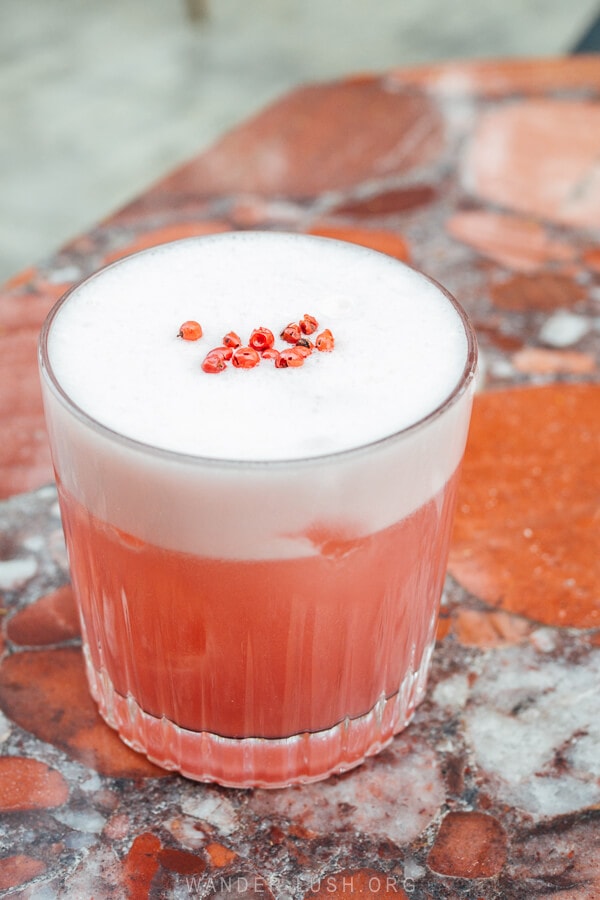
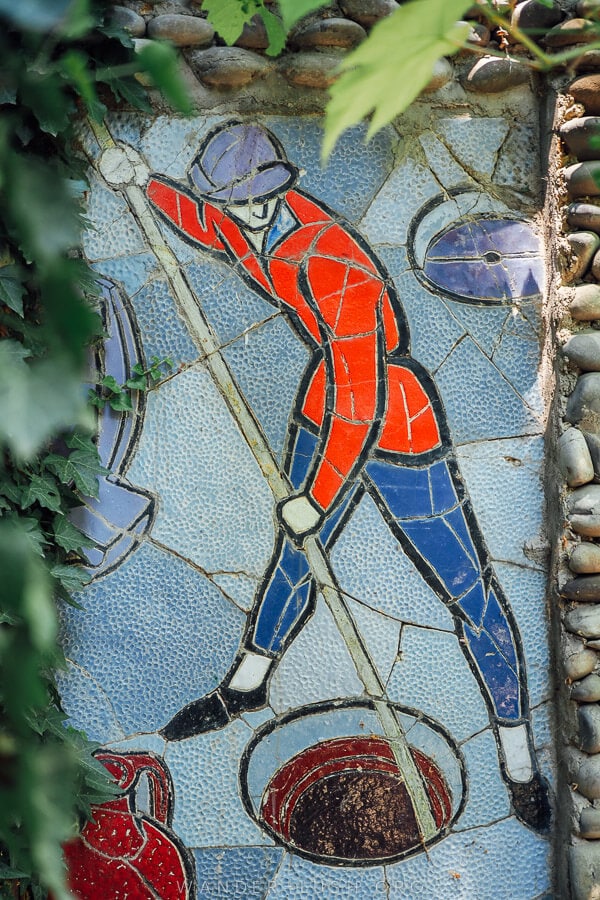
Reminders of the Wine Factory’s past life – old barrels repurposed as pop-up bars, preserved Soviet-style mosaics – dot the extensive grounds. Don’t miss going underground to view the brick cellars, where you can peer through a glass portal at a huge collection of 100-year-old (very dusty) wine and cognac bottles, including several from Stalin’s personal collection apparently!
51. See an adults-only puppet show at the Gabriadze Theatre

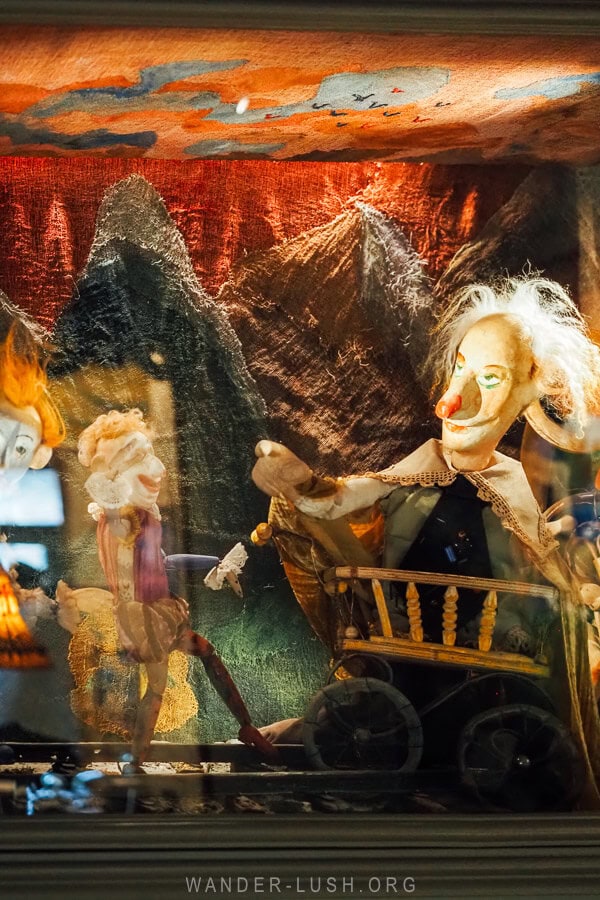
Kutaisi-born Rezo Gabriadze (1936-2021) was a prolific playwright, artist and author who worked in the film industry before founding his Marionette Theatre in Tbilisi 1981. A local institution, the theatre hosts live marionette shows every Tuesday through Sunday, year-round. The plays are in Georgian, with English subtitles are displayed on a screen above the stage.
The sets and costumes (all designed by Rezo himself) are whimsical – but this is not your average puppet theatre. Shows are based on very grown-up storylines (the Siege of Stalingrad, for example), and for this reason, the theatre is strictly adults-only (12 years and over).
Attached to the theatre, the fantastical Gabriadze Universe also includes the Tbilisi Clocktower, which Rezo built himself with debris salvaged from Old Tbilisi. The Gabriadze Cafe (daily from midday) serves nostalgic treats such as ponchiki donuts, and the Gabriadze Shop (daily from 10am) offers tableware and ceramics hand-painted in the on-site studios.
52. Go clubbing in a football stadium basement
If you’re into electronic music, you’ve probably already heard of Bassiani. Located in an old underground swimming pool in the depths of Dinamo Stadium, this club is a world-famous.
During the cooler months (it’s simply too hot down there in summer), local and international DJs perform for thronging crowds of party goers. Bassiani is dark, clouded with cigarette smoke, and irresistibly grungy.
Other popular spots to soak up Tbilisi nightlife include Left Bank, Khidi, and my personal favourite, TES.
What did I miss? What are your favourite things to do in Tbilisi? Feel free to leave your suggestions or questions in the comments below.
Things to do in Tbilisi: Pin it!





